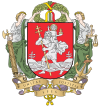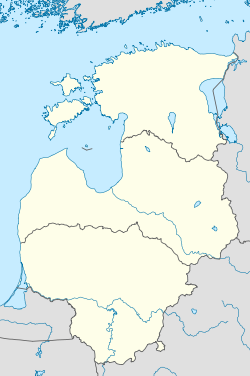Vilnius
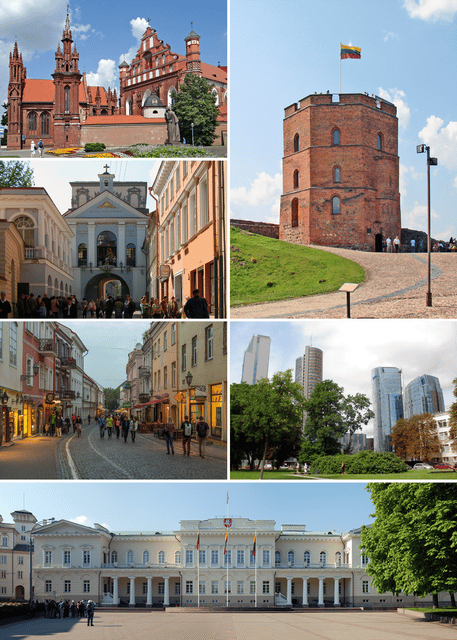
Vilnius

Vilnius | |
|---|---|
City | |
| Nickname(s): | |
| Motto(s): | |
 Interactive map of Vilnius | |
| Coordinates:54°41′N 25°17′E [294] | |
| Country | Lithuania |
| County | Vilnius County |
| Municipality | Vilnius City Municipality |
| Capital of | Lithuania |
| First mentioned | 1323 |
| Granted city rights | 1387 |
| Elderships | List
|
| Government | |
| • Type | City council |
| • Mayor | Remigijus Šimašius |
| Area | |
| • City | 401 km2(155 sq mi) |
| • Metro | 9,731 km2(3,757 sq mi) |
| Elevation | 112 m (367 ft) |
| Population (2019)[7] | |
| • City | 570,806 |
| • Rank | (52nd in EU) |
| • Density | 1,392/km2(3,610/sq mi) |
| • Urban | 697,691 |
| • Metro | 810,290[6] |
| • Metro density | 83/km2(210/sq mi) |
| Demonym(s) | Vilnian |
| Time zone | UTC+2 (EET) |
| • Summer (DST) | UTC+3 (EEST) |
| Postal code | 01001-14191 |
| Area code(s) | (+370) 5 |
| GDP (nominal) Vilnius county[8] | 2017 |
| - Total | €17.2 billion ($20B) |
| - Per capita | €21,300 ($25130) |
| HDI (2017) | 0.896[9] –very high |
| Website | vilnius.lt [295] |
| Official name | Historic Centre of Vilnius |
| Type | Cultural |
| Criteria | ii, iv |
| Designated | 1994 (18th session) |
| Reference no. | [2] [296] |
| UNESCO region | Europe |
Vilnius (Lithuanian pronunciation: [ˈvʲɪlʲnʲʊs] (listen), see also other names) is the capital of Lithuania and its largest city, with a population of 570,806 as of 2019.[7] The population of Vilnius functional urban area, that stretches beyond the city limits, is estimated at 697,691 (as of 2017),[10] while according to statistics of Vilnius territorial health insurance fund, there are 723,016 permanent inhabitants (as of June 2019) in Vilnius city and Vilnius district municipalities combined.[11] Vilnius is in the southeast part of Lithuania and is the second largest city in the Baltic states. Vilnius is the seat of the main government institutions of Lithuania and the Vilnius District Municipality.
Vilnius is classified as a Gamma global city according to GaWC studies, and is known for the architecture in its Old Town, declared a UNESCO World Heritage Site in 1994.[12] Before World War II, Vilnius was one of the largest Jewish centres in Europe. Its Jewish influence has led to it being described as the "Jerusalem of Lithuania" and Napoleon named it "the Jerusalem of the North"[13] as he was passing through in 1812. In 2009, Vilnius was the European Capital of Culture, together with the Austrian city of Linz.[14]
Vilnius | |
|---|---|
City | |
| Nickname(s): | |
| Motto(s): | |
 Interactive map of Vilnius | |
| Coordinates:54°41′N 25°17′E [294] | |
| Country | Lithuania |
| County | Vilnius County |
| Municipality | Vilnius City Municipality |
| Capital of | Lithuania |
| First mentioned | 1323 |
| Granted city rights | 1387 |
| Elderships | List
|
| Government | |
| • Type | City council |
| • Mayor | Remigijus Šimašius |
| Area | |
| • City | 401 km2(155 sq mi) |
| • Metro | 9,731 km2(3,757 sq mi) |
| Elevation | 112 m (367 ft) |
| Population (2019)[7] | |
| • City | 570,806 |
| • Rank | (52nd in EU) |
| • Density | 1,392/km2(3,610/sq mi) |
| • Urban | 697,691 |
| • Metro | 810,290[6] |
| • Metro density | 83/km2(210/sq mi) |
| Demonym(s) | Vilnian |
| Time zone | UTC+2 (EET) |
| • Summer (DST) | UTC+3 (EEST) |
| Postal code | 01001-14191 |
| Area code(s) | (+370) 5 |
| GDP (nominal) Vilnius county[8] | 2017 |
| - Total | €17.2 billion ($20B) |
| - Per capita | €21,300 ($25130) |
| HDI (2017) | 0.896[9] –very high |
| Website | vilnius.lt [295] |
| Official name | Historic Centre of Vilnius |
| Type | Cultural |
| Criteria | ii, iv |
| Designated | 1994 (18th session) |
| Reference no. | [2] [296] |
| UNESCO region | Europe |
Etymology and other names

Iron Wolf
The name of the city originates from the Vilnia River.[15] The city has also been known by many derivative spellings in various languages throughout its history: Vilna was once common in English. The most notable non-Lithuanian names for the city include: Polish: Wilno, Belarusian: Вiльня (Vilnya), German: Wilna, Latvian: Viļņa, Russian: Вильна (Vilna), Ukrainian: Вільно (Vilno), Yiddish: ווילנע (Vilne). A Russian name from the time of the Russian Empire was Вильна (Vilna),[16][17] although Вильнюс (Vilnyus) is now used. The names Wilno, Wilna and Vilna have also been used in older English, German, French and Italian language publications when the city was one of the capitals of Polish–Lithuanian Commonwealth and later an important city in the Second Polish Republic. The name Vilna is still used in Finnish, Portuguese, Spanish, and Hebrew. Wilna is still used in German, along with Vilnius.
The neighborhoods of Vilnius also have names in other languages, which represent the languages spoken by various ethnic groups in the area.
According to the legend, Grand Duke Gediminas (c. 1275–1341) was hunting in the sacred forest near the Valley of Šventaragis, near where Vilnia River flows into the Neris River. Tired after the successful hunt of a wisent, the Grand Duke settled in for the night. He fell soundly asleep and dreamed of a huge Iron Wolf standing on top a hill and howling as strong and loud as a hundred wolves. Upon awakening, the Duke asked the krivis (pagan priest) Lizdeika to interpret the dream. And the priest told him: "What is destined for the ruler and the State of Lithuania, is thus: the Iron Wolf represents a castle and a city which will be established by you on this site. This city will be the capital of the Lithuanian lands and the dwelling of their rulers, and the glory of their deeds shall echo throughout the world." Therefore, Gediminas, obeying the will of the gods, built the city, and gave it the name Vilnius – from the stream of the Vilnia River.[18]
History
Historical affiliations [[INLINE_IMAGE|//upload.wikimedia.org/wikipedia/commons/thumb/a/a6/Coat_of_arms_of_the_Grand_Duchy_of_Lithuania.svg/20px-Coat_of_arms_of_the_Grand_Duchy_of_Lithuania.svg.png|//upload.wikimedia.org/wikipedia/commons/thumb/a/a6/Coat_of_arms_of_the_Grand_Duchy_of_Lithuania.svg/30px-Coat_of_arms_of_the_Grand_Duchy_of_Lithuania.svg.png 1.5x, //upload.wikimedia.org/wikipedia/commons/thumb/a/a6/Coat_of_arms_of_the_Grand_Duchy_of_Lithuania.svg/40px-Coat_of_arms_of_the_Grand_Duchy_of_Lithuania.svg.png 2x|Coat of arms of the Grand Duchy of Lithuania.svg|h27|w20]] Grand Duchy of Lithuania 1323-1569 Polish–Lithuanian Commonwealth 1569–1795 Russian Empire 1795–1915 German Empire 1915–1918 Russian SFSR 1919 Poland 1919-1920 Russian SFSR 1920 Lithuania 1920 [[INLINE_IMAGE|//upload.wikimedia.org/wikipedia/commons/thumb/f/fd/Flaga_Litwy_%C5%9Arodkowej.svg/24px-Flaga_Litwy_%C5%9Arodkowej.svg.png|//upload.wikimedia.org/wikipedia/commons/thumb/f/fd/Flaga_Litwy_%C5%9Arodkowej.svg/36px-Flaga_Litwy_%C5%9Arodkowej.svg.png 1.5x, //upload.wikimedia.org/wikipedia/commons/thumb/f/fd/Flaga_Litwy_%C5%9Arodkowej.svg/48px-Flaga_Litwy_%C5%9Arodkowej.svg.png 2x|Flaga Litwy Środkowej.svg|h15|w24]] Central Lithuania 1920–1922 Poland 1922–1939 Lithuania 1939–1940 Soviet Union 1940–1941 Nazi Germany 1941–1944 [[INLINE_IMAGE|//upload.wikimedia.org/wikipedia/commons/thumb/a/a9/Flag_of_the_Soviet_Union.svg/23px-Flag_of_the_Soviet_Union.svg.png|//upload.wikimedia.org/wikipedia/commons/thumb/a/a9/Flag_of_the_Soviet_Union.svg/35px-Flag_of_the_Soviet_Union.svg.png 1.5x, //upload.wikimedia.org/wikipedia/commons/thumb/a/a9/Flag_of_the_Soviet_Union.svg/46px-Flag_of_the_Soviet_Union.svg.png 2x|Soviet Union|h12|w23|thumbborder flagicon-img flagicon-img]] Soviet Union 1944–1990
Lithuania 1990–present
Early history and Grand Duchy of Lithuania

King Mindaugas Monument
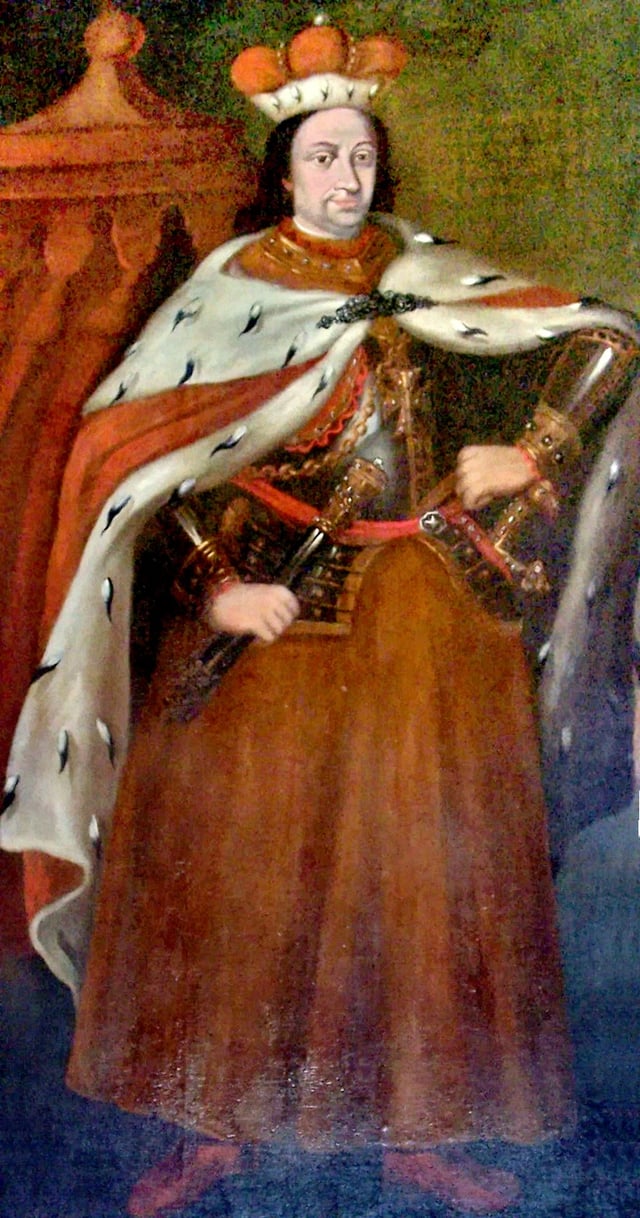
Under the reign of Vytautas the Great, Vilnius emerged as the capital of the Europe's largest state

Palace of the Grand Dukes of Lithuania
Historian Romas Batūra identifies the city with Voruta, one of the castles of Mindaugas, crowned in 1253 as King of Lithuania. During the reign of Vytenis a city started to emerge from a trading settlement and the first Franciscan Catholic church was built.
Vilnius is a historic and a present day capital of Lithuania. Archeological findings indicate that this city was a capital of Lithuanian kingdom and later remained a capital of Lithuanian Grand Dutchy continuously. Also later when Lithuania formed a dual confederation with Poland, Vilnius remained the capital of Lithuania.
The city was first mentioned in written sources in 1323 as Vilna,[19] when the Letters of Grand Duke Gediminas were sent to German cities inviting Germans (including German Jews) to settle in the capital city, as well as to Pope John XXII. These letters contain the first unambiguous reference to Vilnius as the capital; Old Trakai Castle had been the earlier seat of the court of the Grand Duchy of Lithuania.
According to legend, Gediminas dreamt of an iron wolf howling on a hilltop and consulted a pagan priest Lizdeika for its interpretation. He was told: "What is destined for the ruler and the State of Lithuania, is thus: the Iron Wolf represents a castle and a city which will be established by you on this site. This city will be the capital of the Lithuanian lands and the dwelling of their rulers, and the glory of their deeds shall echo throughout the world".[20] The location offered practical advantages: it lay in the Lithuanian heartland at the confluence of two navigable rivers, surrounded by forests and wetlands that were difficult to penetrate. The duchy had been subject to intrusions by the Teutonic Knights.[21]
Vilnius was the flourishing capital of the Grand Duchy of Lithuania, the residence of the Grand Duke. Gediminas expanded the Grand Duchy through warfare along with strategic alliances and marriages. At its height it covered the territory of modern-day Lithuania, Belarus, Ukraine, Transnistria, and portions of modern-day Poland and Russia. His grandchildren Vytautas the Great and Jogaila, however, fought civil wars. During the Lithuanian Civil War of 1389–1392, Vytautas besieged and razed the city in an attempt to wrest control from Jogaila. The two later settled their differences; after a series of treaties culminating in the 1569 Union of Lublin, the Polish–Lithuanian Commonwealth was formed. The rulers of this federation held either or both of two titles: Grand Duke of Lithuania or King of Poland. In 1387, Jogaila acting as a Grand Duke of Lithuania and King of Poland Władysław II Jagiełło, granted Magdeburg rights to the city.
Polish–Lithuanian Commonwealth
The city underwent a period of expansion. The Vilnius city walls were built for protection between 1503 and 1522, comprising nine city gates and three towers, and Sigismund August moved his court there in 1544.
Its growth was due in part to the establishment of Alma Academia et Universitas Vilnensis Societatis Iesu by the Polish King and Grand Duke of Lithuania Stefan Bathory in 1579. The university soon developed into one of the most important scientific and cultural centres of the region and the most notable scientific centre of the Commonwealth.[22]
During its rapid development, the city was open to migrants from the territories of the Crown of the Kingdom of Poland, Grand Duchy and further. A variety of languages were spoken: Polish, German, Yiddish, Ruthenian, Lithuanian, Russian, Old Church Slavonic, Latin, Hebrew, and Turkic languages; the city was compared to Babylon.[21] Each group made its unique contribution to the life of the city, and crafts, trade, and science prospered.
The 17th century brought a number of setbacks. The Commonwealth was involved in a series of wars, collectively known as The Deluge. During the Russo-Polish War (1654–1667), Vilnius was occupied by Russian forces; it was pillaged and burned, and its population was massacred. During the Great Northern War it was looted by the Swedish army. An outbreak of bubonic plague in 1710 killed about 35,000 residents; devastating fires occurred in 1715, 1737, 1741, 1748, and 1749.[21] The city's growth lost its momentum for many years, but even despite this fact, at the end of the 18th century and before the Napoleon wars, Vilnius, with 56,000 inhabitants, entered the Russian Empire as its 3rd largest city.
In the Russian Empire

La Grande Armée in Vilnius during its retreat (near the Vilnius Town Hall) by Jan Krzysztof Damel

In 1905, the Great Seimas of Vilnius took place in the current Lithuanian National Philharmonic Society building
The fortunes of the Commonwealth declined during the 18th century. Three partitions took place, dividing its territory among the Russian Empire, the Habsburg Empire, and the Kingdom of Prussia. After the third partition of April 1795, Vilnius was annexed by the Russian Empire and became the capital of the Vilna Governorate. During Russian rule, the city walls were destroyed, and by 1805 only the Gate of Dawn remained. In 1812, the city was taken by Napoleon on his push towards Moscow, and again during the disastrous retreat. The Grande Armée was welcomed in Vilnius. Thousands of soldiers died in the city during the eventual retreat; the mass graves were uncovered in 2002.[21] Inhabitants expected Tsar Alexander I to grant them autonomy in response to Napoleon's promises to restore the Commonwealth, but Vilnius did not become autonomous, neither by itself nor as a part of Congress Poland.
Following the November uprising in 1831, Vilnius University was closed and Russian repressions halted the further development of the city. Civil unrest in 1861 was suppressed by the Imperial Russian Army.[23]
During the January uprising in 1863, heavy fighting occurred within the city, but was brutally pacified by Mikhail Muravyov, nicknamed The Hangman by the population because of the number of executions he organized. After the uprising, all civil liberties were withdrawn, and use of the Polish[24] and Lithuanian languages was banned.[25] Vilnius had a vibrant Jewish population: according to Russian census of 1897, out of the total population of 154,500, Jews constituted 64,000 (approximately 40%).[26] During the early 20th century, the Lithuanian-speaking population of Vilnius constituted only a small minority, with Polish, Yiddish, and Russian speakers comprising the majority of the city's population.[27]
On December 4 and 5, 1905, the Great Seimas of Vilnius was held in the current Lithuanian National Philharmonic Society building with over 2000 participants. It was the first modern national congress in Lithuania.[28] The assembly made the decision to demand wide political autonomy within the Russian Empire and achieve this by peaceful means. It is considered an important step towards the Act of Independence of Lithuania, adopted on February 16, 1918 by the Council of Lithuania, as the Seimas laid the groundwork for the establishment of an independent Lithuanian state.[29]
In Poland

House of the Signatories in Vilnius

Celebration of incorporation of Vilnius Region to Poland in 1922. The event sparked vast Lithuanians anger with a popular interwar chant: "Mes be Vilniaus nenurimsim!" (English: We will not calm down without Vilnius!).[33]
During World War I, Vilnius and the rest of Lithuania was occupied by the German Army from 1915 until 1918.[30] The Act of Independence of Lithuania, declaring Lithuanian independence from any affiliation to any other nation, was issued in the city on 16 February 1918 with Vilnius as its capital.[31] At the end of 1918 Soviet Russia invades Lithuania with massive forces and thus Lithuanian Army withdraws from Vilnius city to the center of the country in order to form a defense line. German Army withdraws together with a Lithuanian government. Thus the city was briefly controlled by Polish self-defence units, to protect the city from the invaders which were driven out by advancing Soviet forces. Vilnius changed hands again during the Polish–Soviet War and the Lithuanian Wars of Independence: it was taken by the Polish Army, only to fall to Soviet forces again. Shortly after its defeat in the battle of Warsaw, the retreating Red Army, in order to delay the Polish advance, ceded the city to Lithuania after signing the Soviet–Lithuanian Peace Treaty on 12 July 1920.[32]
The League of Nations became involved in the subsequent Lithuanian self defense from Poland after it attacked Lithuanian army positions in the south west part of Lithuania. The League brokered the ceasefire called the Suwałki Agreement on 7 October 1920. Lithuanians believed that it stopped a Polish aggression. Although neither Vilnius or the surrounding region was explicitly addressed in the agreement, numerous historians have described the agreement as allotting Vilnius to Lithuania.[34][35][36][37][38][39][40][41][42] On 9 October 1920, the Polish Army surreptitiously, under General Lucjan Żeligowski, seized Vilnius during an operation known as Żeligowski's Mutiny. The city and its surroundings were designated as a separate state, called the Republic of Central Lithuania. On 20 February 1922 after the highly contested election in Central Lithuania, the entire area was annexed by Poland, with the city becoming the capital of the Wilno Voivodship (Wilno being the name of Vilnius in Polish). Kaunas then became the temporary capital of Lithuania. Lithuania vigorously contested the Polish annexation of Vilnius, and refused diplomatic relations with Poland. The predominant languages of the city were still Polish and, to a lesser extent, Yiddish. The Lithuanian-speaking population at the time was a small minority, at about 6% of the city's population according even to contemporary Lithuanian sources.[43] The Council of Ambassadors and the international community (with the exception of Lithuania) recognized Polish sovereignty over Vilnius Region in 1923.[44]
Vilnius University was reopened in 1919 under the name of Stefan Batory University.[45] By 1931, the city had 195,000 inhabitants, making it the fifth largest city in Poland with varied industries, such as Elektrit, a factory that produced radio receivers.
Nazi Germany had offered Lithuania to join the Invasion of Poland and retake the historical capital Vilnius by force, however President Antanas Smetona and most of the Lithuanian politicians declined this offer because they had doubts about the eventual Adolf Hitler's victory and were outraged by the 1939 German ultimatum to Lithuania. Instead, they supported the neutrality policy and after being encouraged by the French and British diplomats – Lithuania had adopted the Neutrality Act, which was supported by all the political forces.[46]
World War II

Lithuanian Army tanks in Vilnius after regaining control of the capital

Povilas Plechavičius, commander of the LTDF
World War II began with the German invasion of Poland in September 1939. The secret protocols of the Molotov-Ribbentrop Pact had partitioned Lithuania and Poland into German and Soviet spheres of interest. On 19 September 1939, Vilnius was seized by the Soviet Union (which invaded Poland on 17 September). The Soviets and Lithuania concluded a mutual assistance treaty on 10 October 1939, with which the Lithuanian government accepted the presence of Soviet military bases in various parts of the country. On 28 October 1939, the Red Army withdrew from the city to its suburbs (to Naujoji Vilnia) and Vilnius was given over to Lithuania. A Lithuanian Army parade took place on 29 October 1939 through the city centre. The Lithuanians immediately attempted to Lithuanize the city, for example by Lithuanizing Polish schools.[47]
The whole of Lithuania was annexed by the Soviet Union on 3 August 1940 following a June ultimatum from the Soviets demanding, among other things, that unspecified numbers of Red Army soldiers be allowed to enter the country for the purpose of helping to form a more pro-Soviet government. After the ultimatum was issued and Lithuania further occupied, a Soviet government was installed with Vilnius as the capital of the newly created Lithuanian SSR. Between 20,000 and 30,000 of the city's inhabitants were subsequently arrested by the NKVD and sent to gulags in the far eastern areas of the Soviet Union.[48] The Soviets devastated city industries, moving the major Polish radio factory Elektrit, along with a part of its labour force, to Minsk in Belarus, where it was renamed the Vyacheslav Molotov Radio Factory, after Stalin's Minister of Foreign Affairs.
On 22 June 1941, the Germans launched Operation Barbarossa against the Soviet Union, while at the same time Lithuanians began the anti-Soviet June Uprising, organized by the Lithuanian Activist Front. Lithuanians proclaimed independence and organized the Provisional Government of Lithuania. This government quickly self-disbanded.[49] Nazis captured Vilnius on 24 June 1941.[50] Lithuania became part of the Reichskommissariat Ostland, German civil administration.[51] Two ghettos were set up in the old town centre for the large Jewish population – the smaller one of which was "liquidated" by October.[52] The larger ghetto lasted until 1943, though its population was regularly deported in roundups known as "Aktionen".[53] A failed ghetto uprising on 1 September 1943 organized by the Fareinigte Partizaner Organizacje (the United Partisan Organization, the first Jewish partisan unit in German-occupied Europe),[54] was followed by the final destruction of the ghetto. During the Holocaust, about 95% of the 265,000-strong Jewish population of Lithuania was murdered by the German units and Lithuanian Nazi collaborators, many of them in Paneriai, about 10 km (6.2 mi) west of the old town centre (see the Ponary massacre).
In 1944, after the Nazis suffered losses in the Eastern Front and the Red Army was approaching, the Lithuanian Territorial Defense Force (LTDF) was established under the command of general Povilas Plechavičius. The LTDF mission was to defend the country within its borders against the Red Army and the Soviet partisans.[55] On 1 April 1944, the LTDF battalions entered Vilnius and confronted the Armia Krajowa (AK), which attempted to capture the city before the Soviets (see Operation Ostra Brama).[56] The AK tried to negotiate a non-aggression pact with Plechavičius, but the Lithuanian side demanded the Poles to abandon the Vilnius Region or subordinate themselves to Lithuanians.[57] The 19 500 men LTDF disbanded itself after refusing to transcend the Lithuanian border and to aid the Nazis in the Eastern Front. Many of the former LTDF members later formed the core of the Lithuanian partisans (e.g., Jonas Žemaitis).[58]
In the Lithuanian SSR (Soviet Union)
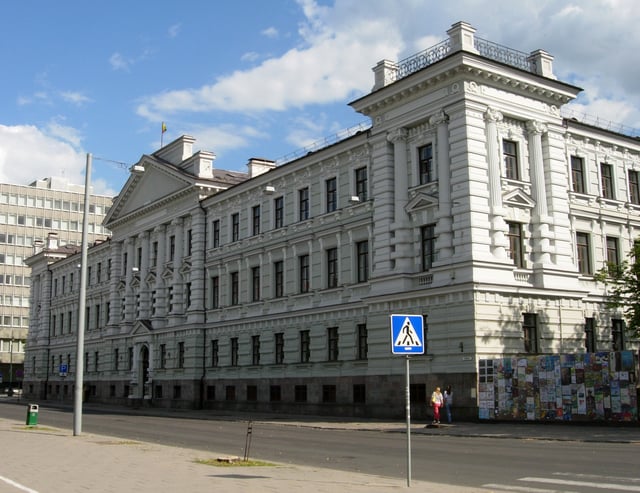
The former KGB headquarters in Vilnius, now the Museum of Occupations and Freedom Fights
The war had irreversibly altered the town – most of the predominantly Polish and Jewish population had been repatriated and exterminated respectively, during and after the German occupation. Some members of the intelligentsia and partisan members hiding in the forest were now targeted and deported to Siberia after the war. The majority of the remaining population was compelled to move to Communist Poland by 1946, and Sovietization began in earnest.
From the late 1940s on Vilnius began to grow again, following an influx of Lithuanians, Poles and Belarusians from neighbouring regions within Lithuania as well as neighbouring region of Grodno and from other more remote areas of the Soviet Union (particularly Russia, Belarus and Ukraine). On the previously rural outskirts as well as in the very vicinity of the Old town (industrial zones in Paupys, Markučiai, Naujamiestis), industrial areas were designed and large Soviet plants were built, following a program of industrialization.
In November 1980 the number of inhabitants of Vilnius exceeded 500,000. Because of shortage of housing for a growing population of the city, large scale Microdistricts (so-called sleeping districts) were built in the elderates of Antakalnis, Žirmūnai, Lazdynai, Karoliniškės, Viršuliškės, Baltupiai, Justiniškės, Pašilaičiai, Fabijoniškės and on a smaller scale in other parts of Vilnius. These were connected with the central part as well as with industrial areas via expressway-like streets (so-called fast traffic streets) and by public transport, noticeably extensive network of trolleybuses (from 1956).
Independent Lithuania
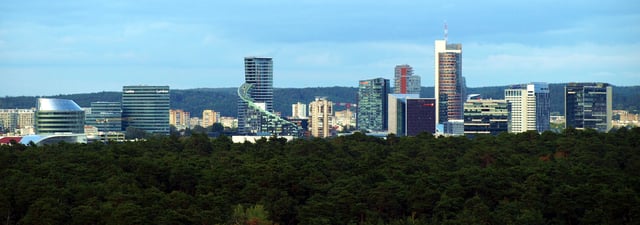
Skyline of the New City Center from Karoliniškės outcrop, with the most high-rise buildings constructed in the last two decades after the Act of the Re-Establishment of the State of Lithuania was declared
On 11 March 1990, the Supreme Council of the Lithuanian SSR announced its secession from the Soviet Union and intention to restore an independent Republic of Lithuania.[62] As a result of these declarations, on 9 January 1991, the Soviet Union sent in troops. This culminated in the 13 January attack on the State Radio and Television Building and the Vilnius TV Tower, killing at least fourteen civilians and seriously injuring 700 more.[63] The Soviet Union finally recognised Lithuanian independence in September 1991.[64] The current Constitution, as did the earlier Lithuanian Constitution of 1922, mentions that "the capital of the State of Lithuania shall be the city of Vilnius, the long-standing historical capital of Lithuania".
Vilnius has been rapidly transformed, and the town has emerged as a modern European city. Many of its older buildings have been renovated, and a business and commercial area is being developed into the New City Centre, expected to become the city's main administrative and business district on the north side of the Neris river. This area includes modern residential and retail space, with the municipality building and the 129-metre (423 ft) Europa Tower as its most prominent buildings. The construction of Swedbank's headquarters is symbolic of the importance of Scandinavian banks in Vilnius. The building complex Vilnius Business Harbour was built in 2008, and one of its towers is now the 5th tallest building in Lithuania. More buildings are scheduled for construction in the area. Vilnius was selected as a 2009 European Capital of Culture, along with Linz, the capital of Upper Austria. Its 2009 New Year's Eve celebration, marking the event, featured a light show said to be "visible from outer space".[65] In preparation, the historical centre of the city was restored, and its main monuments were renovated.[66] The global economic crisis led to a drop in tourism which prevented many of the projects from reaching their planned extent, and allegations of corruption and incompetence were made against the organisers,[67][68] while tax increases for cultural activity led to public protests[69] and the general economic conditions sparked riots.[70] In 2015 Remigijus Šimašius became the first directly elected mayor of the city.[71]
On 28–29 November 2013, Vilnius hosted the Eastern Partnership Summit in the Palace of the Grand Dukes of Lithuania. Many European presidents, prime ministers and other high-ranking officials participated in the event.[72] On 29 November 2013, Georgia and Moldova signed association and free trade agreements with the European Union.[73] Previously, Ukraine and Armenia were also expected to sign the agreements but postponed the decision, sparking large protests in Ukraine.
Geography

Neris River at Mindaugas Bridge with Vilnius Upper Castle in the distance
Vilnius is situated in south-eastern Lithuania (54°41′N 25°17′E [297] ) at the confluence of the Vilnia and Neris Rivers. Lying close to Vilnius is a site some claim to be the Geographical Centre of Europe.
Vilnius lies 312 km (194 mi) from the Baltic Sea and Klaipėda, the chief Lithuanian seaport. Vilnius is connected by highways to other major Lithuanian cities, such as Kaunas (102 km or 63 mi away), Šiauliai (214 km or 133 mi away) and Panevėžys (135 km or 84 mi away).
The current area of Vilnius is 402 square kilometres (155 sq mi). Buildings occupy 29.1% of the city; green spaces occupy 68.8%; and waters occupy 2.1%.[74]
Climate
The climate of Vilnius is humid continental (Köppen climate classification Dfb).[75] Temperature records have been kept since 1777.[76] The average annual temperature is 6.7 °C (44 °F); in January the average temperature is −4.3 °C (24 °F), in July it is 18.1 °C (65 °F). The average precipitation is about 682 millimetres (26.85 in) per year. Average annual temperatures in the city have increased significantly during the last 30 years, a change which the Lithuanian Hydrometeorological Service attributes to global warming induced by human activities.[77]
Summer days are pleasantly warm and sometimes hot, especially in July and August, with temperatures above 30 °C (86 °F) throughout the day during periodic heat waves. Night-life in Vilnius is in full swing at this time of year, and outdoor bars, restaurants and cafés become very popular during the daytime.
Winters can be very cold, with temperatures rarely reaching above freezing – temperatures below −25 °C (−13 °F) are not unheard-of in January and February. Vilnius's rivers freeze over in particularly cold winters, and the lakes surrounding the city are almost always permanently frozen during this time of year. A popular pastime is ice-fishing.
| Climate data for Vilnius (1981–2010 normals, sun 1961–1990) | |||||||||||||
|---|---|---|---|---|---|---|---|---|---|---|---|---|---|
| Month | Jan | Feb | Mar | Apr | May | Jun | Jul | Aug | Sep | Oct | Nov | Dec | Year |
| Record high °C (°F) | 11.0 (51.8) | 14.4 (57.9) | 19.8 (67.6) | 29.0 (84.2) | 31.8 (89.2) | 34.2 (93.6) | 36.4 (97.5) | 34.9 (94.8) | 33.1 (91.6) | 24.5 (76.1) | 15.5 (59.9) | 10.5 (50.9) | 36.4 (97.5) |
| Average high °C (°F) | −1.9 (28.6) | −1.2 (29.8) | 3.8 (38.8) | 12.0 (53.6) | 18.4 (65.1) | 20.8 (69.4) | 23.2 (73.8) | 22.4 (72.3) | 16.6 (61.9) | 10.2 (50.4) | 3.2 (37.8) | −0.8 (30.6) | 10.6 (51.1) |
| Daily mean °C (°F) | −4.3 (24.3) | −4 (25) | 0.2 (32.4) | 7.1 (44.8) | 12.9 (55.2) | 15.7 (60.3) | 18.1 (64.6) | 17.3 (63.1) | 12.3 (54.1) | 6.9 (44.4) | 1.1 (34.0) | −3 (27) | 6.7 (44.1) |
| Average low °C (°F) | −6.6 (20.1) | −6.8 (19.8) | −3.4 (25.9) | 2.1 (35.8) | 7.3 (45.1) | 10.6 (51.1) | 13.0 (55.4) | 12.1 (53.8) | 7.9 (46.2) | 3.6 (38.5) | −1.1 (30.0) | −5.2 (22.6) | 2.4 (36.3) |
| Record low °C (°F) | −37.2 (−35.0) | −35.8 (−32.4) | −29.6 (−21.3) | −14.4 (6.1) | −4.4 (24.1) | 0.1 (32.2) | 3.5 (38.3) | 1.0 (33.8) | −4.8 (23.4) | −14.4 (6.1) | −22.8 (−9.0) | −30.5 (−22.9) | −37.2 (−35.0) |
| Average precipitation mm (inches) | 48.7 (1.92) | 38.2 (1.50) | 42.1 (1.66) | 41.6 (1.64) | 56.3 (2.22) | 78.6 (3.09) | 86.3 (3.40) | 72.3 (2.85) | 63.3 (2.49) | 54.7 (2.15) | 47.7 (1.88) | 52.6 (2.07) | 682.3 (26.86) |
| Average precipitation days | 12.4 | 10.5 | 9.6 | 8.6 | 9.6 | 11.4 | 10.7 | 9.6 | 9.6 | 10.1 | 10.4 | 12.2 | 124.8 |
| Mean monthly sunshine hours | 36 | 71 | 117 | 164 | 241 | 231 | 219 | 217 | 140 | 94 | 33 | 25 | 1,588 |
| Average ultraviolet index | 0 | 1 | 2 | 3 | 5 | 6 | 6 | 5 | 3 | 2 | 1 | 0 | 3 |
| Source: WMO (avg high and low)[78] NOAA (sun, extremes, and mean temperatures)[79], Météo Climat[80] and Weather Atlas[81] | |||||||||||||
Culture

Old town of Vilnius

Bust of Frank Zappa

Vilnius Picture Gallery

The Chapel of Saint Casimir in the Cathedral of Vilnius

Lithuanian National Drama Theatre
There are 65 churches in Vilnius. Like most medieval towns, Vilnius was developed around its Town Hall. Pilies Street, the main artery, links the Royal Palace with Town Hall. Other streets meander through the palaces of feudal lords and landlords, churches, shops and craftsmen's workrooms. Narrow, curved streets and intimate courtyards developed in the radial layout of medieval Vilnius.
The Old Town of Vilnius is the historical centre of Vilnius about 3.6 km2 (1.4 sq mi) in size. The most valuable historic and cultural sites are concentrated here. The buildings in the old town—there are nearly 1,500—were built over several centuries, creating a blend of many different architectural styles. Although Vilnius is known as a Baroque city, there are examples of Gothic (e.g., Church of St. Anne), Renaissance, and other styles. Their combination is also a gateway to the historic centre of the capital. Owing to its uniqueness, the Old Town of Vilnius was inscribed on the UNESCO World Heritage List in 1994.[12] Vilnius University's main campus's features 13 courtyards framed by 15th century buildings and splashed with 300-year-old frescoes, and the Church of St. Johns. The Gate of Dawn, the only surviving gate of the first original five gates in the city wall, hosts the painting of the Blessed Virgin Mary, which has been said to have miracle-working powers. Over 200 tiles and commemorative plaques to writers, who have lived and worked in Vilnius, and foreign authors, who have shared a connection with Vilnius and Lithuania, adorn a wall on Literatų street (Lithuanian: Literatų gatvė) in the Old Town, presenting a broad overview of the history of Lithuanian literature. In Antakalnis district there is Church of St. Peter and St. Paul – a masterpiece of the 17th-century Baroque famous for its exceptional interior where one can see about 2,000 stucco figures.
In 1995, the world's first bronze cast of Frank Zappa[82] was installed in the Naujamiestis district with the permission of the government. The Frank Zappa sculpture confirmed the newly found freedom of expression and marked the beginning of a new era for Lithuanian society.
The Vilnius Castle Complex, a group of defensive, cultural, and religious buildings that includes Gediminas Tower of the Upper Castle (which is a part of National Museum of Lithuania), Cathedral Square and the Palace of the Grand Dukes of Lithuania. Lithuania's largest art collection is housed in the Lithuanian Art Museum. One branch of it, the Vilnius Picture Gallery in the Old Town, houses a collection of Lithuanian art from the 16th to the beginning of the 20th century. On the other side of the Neris, the National Art Gallery holds a permanent exhibition on Lithuanian 20th-century art, as well as numerous exhibitions on modern art. The House of the Signatories, where the 1918 Act of Independence of Lithuania was signed, is now a historic landmark. The Museum of Genocide Victims is dedicated to the victims of the Soviet era.
The Contemporary Art Centre is the largest venue for contemporary art in the Baltic States, with an exhibition space of 2400 square meters. The Centre is a non-collection based institution committed to developing a broad range of international and Lithuanian exhibition projects as well as presenting a wide range of public programmes including lectures, seminars, performances, film and video screenings, and live new music events.
The biggest book fair in Baltic States is annually held in Vilnius at LITEXPO, the Baltic's biggest exhibition centre.[83]
On 10 November 2007, the Jonas Mekas Visual Arts Center was opened by avant-garde filmmaker Jonas Mekas. Its premiere exhibition was entitled The Avant-Garde: From Futurism to Fluxus.
MO Museum opened in 2018 is a personal initiative of Lithuanian scientists and philanthropists Danguolė and Viktoras Butkus. Its collection of 5000 modern and contemporary pieces contains major Lithuanian artworks from the 1950s to this day.[84]
The Užupis district near the Old Town, which used to be one of the more run down districts of Vilnius during the Soviet era, is home to a movement of bohemian artists, who operate numerous art galleries and workshops. Užupis declared itself an independent republic on April Fool's Day in 1997.[85] In the main square, the statue of an angel blowing a trumpet stands as a symbol of artistic freedom.
In 2015, the project of Vilnius Talking Statues was realized. 15 statues around Vilnius now interact with visitors in multiple languages by a simple telephone call to a smart phone.[86]
Vilnius City Opera – an independent opera theatre in Lithuania, blends classical with contemporary art. Lithuanian National Drama Theatre, State Small Theatre of Vilnius, State Youth Theatre and a number of private theatre companies, including OKT / Vilnius City Theatre, Anželika Cholina dance theatre and others, show classical, modern and Lithuanian playwriting directed by world-known Lithuanian and foreign directors.
The Lithuanian National Philharmonic Society is the largest and oldest state owned concert organization in Lithuania, whose main activity is to organise and coordinate live concerts, diverse classical/classical contemporary/jazz music events and tours throughout Lithuania and abroad.[87] The Lithuanian State Symphony Orchestra every year builds up a wide-ranging repertoire, introduces exceptional programs, and invites young talent to perform along with outstanding and recognized soloists.
Cinema

Billboard above the Botanical Garden (now Bernardinai Garden) main gates of the first cinema screening in Vilnius (1897)

Lithuanian Theater, Music and Cinema Museum, located in the 17th century Minor Radvilos Palace
The very first public film session in Vilnius was held in the Botanical Garden (now Bernardinai Garden) in the summer of 1897. It is notable that such an event was held in Vilnius soon after the very first film sessions in the world by Auguste and Louis Lumière, who held it in Paris in 1895. Vilnius film session also showed the Lumière brothers movies, which were documentaries. Firstly shown movies were educational and were filmed in exotic locations (e.g., India, Africa) and introduced different cultures to Vilnians, who enjoyed the movies because very few were able to visit such far places. Georges Méliès' movie A Trip to the Moon was first shown in the non-stationary Lukiškės Square movie theater in 1902 and was the first feature film shown in Vilnius.[88]
First stationary movie theater in Vilnius was opened in 1905 and was called Iliuzija (English: Illusion) and was located in Didžioji St. 60.[89] First movie theaters reminded theatres buildings and had boxes with more expensive tickets. Also, because there was no sound in the first movies, the sessions had a live orchestral or musicians performances. On stage, cinema screening was sometimes mixed with theatrical performances, illusion shows.[88]
On 4 June 1924, Vilnius Magistrate estabished a popular 1200 seats movie theater in the city hall, which in Polish was called Miejski kinematograf (English: City Movie Theater). The purpose of this cinema was to provide cultural education for students and adults. The popularity of this cinema is evidenced by the numbers of viewers in 1926: 502 261 tickets were sold, 24 242 tickets were given free to boarding children, 778 to Vilnius guests and 8385 to soldiers. In 1939, the Lithuanian authorities renamed it to Milda. In 1940, the last city government handed over the premises to the People's Commissariat of Education, which established a Lithuanian National Philharmonic Society there.[89]
In 1965, the most modern movie theater in Lithuania called Lietuva was opened in Vilnius, which annually had over 1.84 million visitors and profit of over 1 million Soviet rubles. After the reconstruction, it had one of the largest screens in Europe (200 square metres).[89] Though, it was closed in 2002, demolished in 2017 and the MO Museum was built instead of it.[90]
Lithuanian Film Center (Lithuanian: Lietuvos kino centras), which main task is to promote the development and competitiveness of the Lithuanian film industry, headquarters are in Vilnius.[91]
Language

Privilege to Vilnius Cathedral issued by Vytautas the Great in Vilnius on February 16, 1410 in Latin language

Manuscript of the Constitution of 3 May 1791 in Lithuanian[92]
As a historically multicultural capital, many languages statuses changed over the centuries in the history of Vilnius. The predominant language of public life in medieval Lithuania was Lithuanian language. It was spoken by people living in the ethnopolitical center of the state - ethnic Lithuania, including the ruler's manor and the most prominent Lithuanian nobility. However, the Lithuanian language had no literary traditions and was not used in writing, except for the most important religious texts (e.g., the Lord's and the Hail Mary prayers).[93][94] Although, the importance of the spoken Lithuanian language remained for centuries because it is known that even Vytautas the Great himself knew and spoke in the Lithuanian language with Władysław II Jagiełło, whose son Casimir IV Jagiellon also spoke in the Lithuanian language.[95][96]
Ruthenian language was used in Lithuania and its capital Vilnius due to the incorporation of the Kievan Rus' lands. In colloquial form, these dialects formed the basis of the Ukrainian and Byelorussian languages in the 19th century. The written form of the Ruthenian language formed from the interaction of the ancient Slavic language with the local elements of the Ruthenian language. Such a Ruthenian language became the main language of the Chancery of the Grand Duchy of Lithuania in the 14th-15th centuries and maintained its dominant position until the middle of the 17th century.[93][97]
Latin and Polish languages were also widely used in the Chancery of the Grand Duchy of Lithuania. In the second part of the 17th century, the Polish language ousted the Ruthenian language from the written sources and the Lithuanian language from most areas of the public life. The first state documents in the Lithuanian language appeared in the Grand Duchy of Lithuania only at the very end of its existence (e.g., Constitution of 3 May 1791 and the Great Sejm Lithuanian manuscripts, Kościuszko Uprising Lithuanian notes).[93]
Minorities (e.g., Lithuanian Jews, Lipka Tatars, Crimean Karaites) were under guardianship of the Grand Duke of Lithuania, but their languages were only used among themselves and never gained a significant role. The 2nd and 3rd Statutes of Lithuania consolidated Lithuanian Jews status as non-Christian and "common human" (non-noble).[98]
According to the 14th article of the modern Constitution of Lithuania, the Lithuanian language is the only official language in the state. Therefore, all the official procedures in Vilnius must be proceeded in the Lithuanian language, however the interpreter assistance is guaranteed by the state in some cases.[99]
Administration
City government
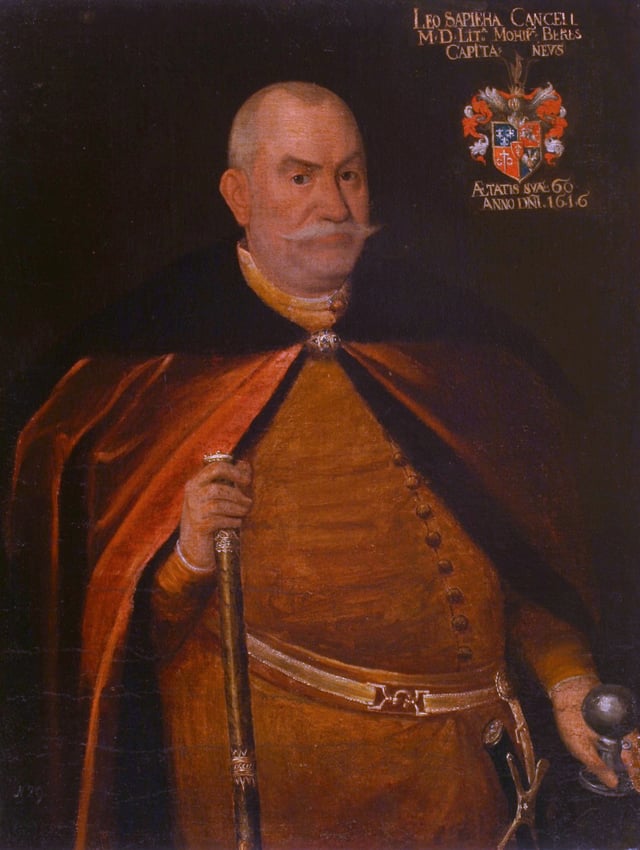
Lew Sapieha (Voivode of Vilnius from 1623 till his death in 1633) was one of the greatest leaders of the Grand Duchy of Lithuania at the times of the Duchy's highest cultural flourishing

Vilnius Town Hall, reconstructed in neoclassical style according to the design by Laurynas Gucevičius in 1799
Before the Magdeburg rights were granted to Vilnius in 1378, the city was overseen by the ruler's vicegerents. Later these duties were granted to a magistrate or a City Council, subordinate only to the ruler himself. During wars, when the city was in a danger, the city was led by a Voivode of Vilnius.[100]
Vilnius Magistrate was responsible for the city economy, was collecting taxes, taking care of the city treasury, was accumulating stocks of grain in order to avoid residents starvation in case of famine or wars. He also acted as a notary in transactions, testaments and as a judge during the city residents conflicts that involved new buildings constructions and reconstructions. His other function was taking care of the city craftsmen. From the beginning, statutes of workshops were approved by the ruler himself. Later, Sigismund II Augustus granted this privilege to the city magistrates in 1552. Since the 1522 privilege by Sigismund I the Old, Vilnius Magistrates had the responsibility to protect the city and its resident's tranquility by having 24 armed guards. During war times, the night watch was performed by three jurisdictions – magistrate, bishop and castle men.[100]
Chief City Administrator was vaitas (a Grand Duke of Lithuania vicegerent in the city). Most of them were beginning their careers in the magistracy before obtaining such a position. All vaitai were Catholics. Vaitas was chairing during the City Council meetings. His competence also included criminal cases and he had the right to impose a death penalty. At first, he examined the cases alone, however since the 16th century two suolininkai also examined important cases (if the lawsuit was over 10 groschen) together with the vaitas. In the 16th century, Vilnius City Council consisted of 12 burgomasters and 24 councilors (half of them were Catholics, the other half were orthodoxes). There were no direct elections to the City Council and members to the council were chosen by the wealthy townspeople, merchants, workshops seniors. Burgomasters were being chosen until their deaths. In case of death, another member of the council was being chosen of the same religion. In 1536, Sigismund I the Old signed a privilege which regulated the magistracy formation principles that prohibited to choose close relatives to the council and all the new taxes, obligations and regulations required the prior agreement of the townspeople.[100]
Under the Russian Empire control, the City Council was replaced with City Duma. After the Soviet occupation of Lithuania, Vilnius became a republican subordinate city. Current Vilnius city municipality was established only in 1995.
Municipal council of the city

Remigijus Šimašius is the current Mayor of Vilnius since 2015
Vilnius City Municipality is one of 60 municipalities of Lithuania and includes the nearby town of Grigiškės, three villages, and some rural areas. The town of Grigiškės was separated from the Trakai District Municipality and attached to the Vilnius City Municipality in 2000.
A 51-member council is elected to four-year terms; the candidates are nominated by registered political parties. As of the 2011 elections, independent candidates also were permitted. The last election was held on March 2019. The results are:
Public Election Committee "R. Šimašius Team "For Vilnius, which we are proud of"- 17 seats
A. Zuokas and Vilnius Citizens Coalition "Happy Vilnius" - 10 seats
Homeland Union – Lithuanian Christian Democrats - 9 seats
The coalition of the Electoral Action of Poles in Lithuania and Russians Alliance "Christian Families Alliance" - 6 seats
Labour Party - 5 seats
Lithuanian Farmers and Greens Union - 3 seats[101]
Mayors

New Vilnius city municipality building in Konstitucijos Avenue
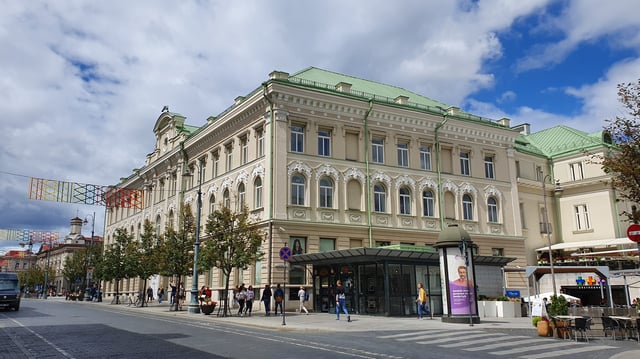
Former municipality building in Gediminas Avenue, used until 2004, now is a shopping mall GO9
Before 2015, mayors were appointed by the council. Starting with the elections in 2015, the mayors are elected directly by the residents. Remigijus Šimašius became the first directly elected mayor of the city.
1990 – Arūnas Grumadas (the president of council)
1993 – Valentinas Šapalas (the president of council)
1995 – Alis Vidūnas
1997 – Rolandas Paksas
1999 – Juozas Imbrasas
2000 – Rolandas Paksas (second time)
2001 – Artūras Zuokas
2003 – Gediminas Paviržis
2003 – Artūras Zuokas (second time)
2007 – Juozas Imbrasas (second time)
2009 – Vilius Navickas
2010 – Raimundas Alekna
2011 – Artūras Zuokas (third time)
2015 – Remigijus Šimašius
2019 – Remigijus Šimašius (second time)[102]
Subdivisions

Map of Vilnius elderships. Numbers on the map correspond with numbers in the list
Elderships, a statewide administrative division, function as municipal districts. The 21 elderships are based on neighbourhoods:
Verkiai – includes Baltupiai, Jeruzalė, Santariškės, Balsiai, Visoriai
Antakalnis – includes Valakampiai, Turniškės, Dvarčionys
Pašilaičiai – includes Tarandė
Fabijoniškės – includes Bajorai
Pilaitė
Justiniškės
Viršuliškės
Šeškinė
Šnipiškės
Žirmūnai – includes Šiaurės miestelis
Karoliniškės
Žvėrynas
Grigiškės – a separate town
Lazdynai
Vilkpėdė – includes Vingis Park
Naujamiestis – includes bus and train stations
Senamiestis (Old Town) – includes Užupis
Naujoji Vilnia – includes Pavilnys, Pūčkoriai
Paneriai – includes Trakų Vokė, Gariūnai
Naujininkai – includes Kirtimai, Salininkai, Vilnius International Airport
Rasos – includes Belmontas, Markučiai[103]
District municipality

Medininkai Castle, built in the first half of the 14th century. It is the largest enclosure type defensive castle in Lithuania and one of the primary landmarks of the Vilnius district.[104]
Vilnius District Municipality (Lithuanian: Vilniaus rajono savivaldybė) is one of the largest municipalities in Lithuania. It occupies 2129 square kilometres and has 23 civil parishes. There are 1163 villages and 5 towns (Nemenčinė, Bezdonys, Maišiagala, Mickūnai and Šumskas) in the district. Vilnius district surrounds the Lithuania's capital and has developed public, business rural infrastructure and offers high standard of living with clean environment. Vilnius district borders with the Republic of Belarus and neighbours with Švenčionys, Moletai, Širvintos, Elektrėnai, Trakai and Šalčininkai districts.[105]
Vilnius district has a multinational population, of which 52% are Poles, 33% are Lithuanians and the rest of 16% are Russians, Belarusians and other nationalities residents (e.g., Ukrainians, Tatars, Jews). Currently, Vilnius district has over 100 000 residents. Most of the population (95%) lives in villages and only 5% lives in towns.[105]
Medininkai Castle, Liubavas Manor mill and Bareikiškės Manor are the most famous historical landmarks of the district.[105]
National government

Seimas Palace in Vilnius, where the parliamentarians of Lithuania gathers
As the capital of Lithuania, Vilnius is the seat of Lithuania's national government. For the executive, the two chief officers of Lithuania have their offices in Vilnius. The President of the Republic of Lithuania resides at the Presidential Palace in Daukanto Square,[109] while the Prime Minister's seat is at the Government of Lithuania office in the Gediminas Avenue.[110] According to the Law of the President of the Republic of Lithuania, the President of the Republic has a residence in Vilnius that is currently located in Turniškės district near Neris river.[111][112] Prime Minister also has a right to a residence in Turniškės district during term in office.[113] Government ministries are located in various parts of the city; many are located in the Vilnius Old Town.[114]
The Seimas of the Republic of Lithuania is also located in Vilnius and meets at the Seimas Palace in Gediminas Avenue.[115]
Lithuania's highest courts are located in Vilnius. The Supreme Court of Lithuania (Lithuanian: Lietuvos Aukščiausiasis Teismas), the highest court in the judicial order, which reviews criminal and civil cases, is located in the Gynėjų street,[116] while the Supreme Administrative Court of Lithuania (Lithuanian: Lietuvos vyriausiasis administracinis teismas), which acts as the highest court in the administrative order, judging litigation against public bodies, is located in the Žygimantų street.[117] The Constitutional Court of Lithuania (Lithuanian: Lietuvos Respublikos Konstitucinis Teismas), an advisory body with ultimate authority on the constitutionality of laws meets in the Constitutional Court's Palace in Gediminas Avenue.[118]
The Lithuanian Tribunal, which was the highest appeal court for the nobility of the Grand Duchy of Lithuania, was established by Stephen Báthory, Grand Duke of Lithuania and King of Poland, in 1581 and was located in Vilnius till 1795.[119]
Special services

Emergency Response Center (112) in Antakalnis, which deals with the emergency calls in Vilnius.
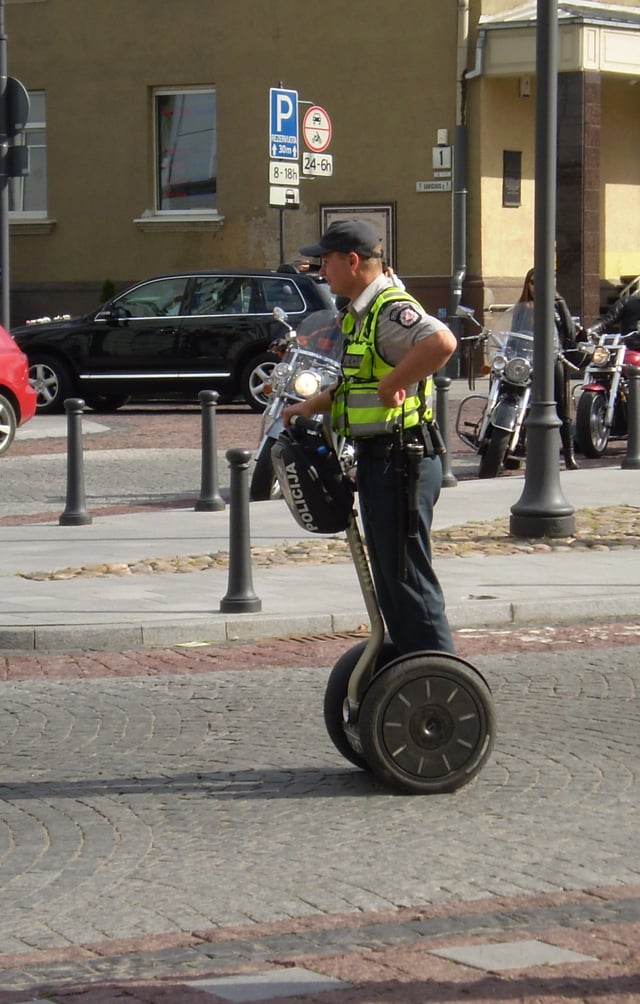
Lithuanian Police officer, patrolling with a Segway.
The security of Vilnius is mainly the responsibility of the Vilniaus apskrities vyriausiasis policijos komisariatas, the highest police office in the city, and local police offices. Its main responsibilities are ensuring public order and public safety, disclosure and investigation of criminal offenses and traffic safety supervision.[120] In 2016, there were 1500 police officers in Vilnius.[121] Viešojo saugumo tarnyba prie Vidaus reikalų ministerijos is responsible for the prompt restoration of public order in extreme and special situations and ensure proper protection of important state objects and escorted subjects.[122]
Vilniaus greitosios medicinos pagalbos stotis is responsible for emergency medical services in the city and can be contacted directly by calling a short number 033.[125] It is one of the oldest emergency medical services institution in Eastern Europe and was established already in 1902.[126] Large part of this institution doctors and other personnel were awarded with medals for their assistance to victims during the January Events in 1991.[126]
Major number for contacting all the special services in Vilnius (and other regions of Lithuania) is 112.[127]
Cityscape
Urbanism and architecture

Church of St. Francis and St. Bernard is an outstanding example of Gothic architecture in Lithuania

Church of St. Peter and St. Paul is a Baroque architecture masterpiece
The Vilnius Historic Centre history begins from the Neolithic period. During it, the glacial hills were intermittently occupied and a wooden castle, at the confluence of the Neris and Vilnia rivers, was built around 1000 AD to fortify Gedimino Hill. The settlement developed into a town only in the 13th century, when the pagan Baltic people were invaded by the Westerners during the Lithuanian Crusade. Around 1323, when the first written sources about Vilnia occurred, it was the capital of the Grand Duchy of Lithuania, which was formed from various cultures and nationalities residents. At this time, it only had some brick structures. By the 15th century, the Grand Duchy of Lithuania had become one of the most powerful and the largest country in Europe with its territory stretching from the Baltic Sea to the Black Sea (mostly, present-day Belarus, Ukraine and Russia lands). The historic centre consists of three castles territories (Upper, Lower and Curved) and the area that was previously encircled by a Wall of Vilnius. Its plan is mostly circular with its center in the original castle site. The streets pattern is medieval and has small, narrow streets, however large squares were also developed in later periods.[128]
The historic buildings are in Gothic (e.g., Church of St. Anne),[131] Renaissance (e.g., Palace of the Grand Dukes of Lithuania),[132] Baroque (e.g., Church of St. Peter and St. Paul, Vilnius University old town complex and its Grand Courtyard)[133] and Classical styles (e.g., Vilnius Cathedral, Vilnius Town Hall, Šuazeliai Palace, Verkiai Palace)[134] with splendid exteriors and interiors. The variety of preserved churches and former palaces of the Lithuanian nobility especially constitutes the Vilnius multicultural heritage.[128][135]
As a capital of the massive state, Lithuanians shaped the development of its outstanding capital together with other nations. Vilnius development was influenced by West and the East ideologies. Christianity dominated in Lithuania since the Christianization of Lithuania in 1387, however Orthodoxy of the state's eastern residents and the growing importance of Judaism led to exemplary material manifestations of these religious communities (e.g., Orthodox Cathedral of the Theotokos, Great Synagogue of Vilna).[128]
Various disasters resulted in reconstructions of the Vilnius buildings in the School of Vilnius Baroque style, which later left an imprint in the whole Grand Duchy of Lithuania.[128] Talented artists (e.g., Matteo Castelli, Pietro Perti) from the present-day Canton of Ticino were particularly preferred by the Grand Duke of Lithuania and local nobility, and developed many famous objects in the city (e.g., Chapel of Saint Casimir).[136] Lithuanian Laurynas Gucevičius left a huge mark in the Classical style architecture of Vilnius.[137]
Vilnius Old Town was inscribed to the list of the UNESCO World Heritage Sites in 1994. The inscribed property has an extension of 352 ha. Vilnius Historic Centre is particularly noted for maintaining the medieval streets pattern without any significant gaps. However, some places were damaged during Lithuania's occupations and wars, including the Cathedral Square that covers the foundations of the Royal Palace, which was demolished after the 3rd partition of the Polish-Lithuanian Commonwealth in 1795, a square in the east from the Church of All Saints where the Convent of the Barefoot Carmelites previously stood alongside a Vice-Chancellor Stefan Pac's established Baroque Church of St. Joseph the Betrothed, both of which were demolished by the tsar's order. Great Synagogue and part of the buildings in the Vokiečių Street (Deutsche Gasse) were demolished after the World War II.[128]
Vilnius occupies an area of 397 square kilometers, of which only one fifth is developed and the remainder is green belt and water. For this reason, Vilnius is often referred to as one of the 'greenest' capital cities in Europe.[142]
Housing
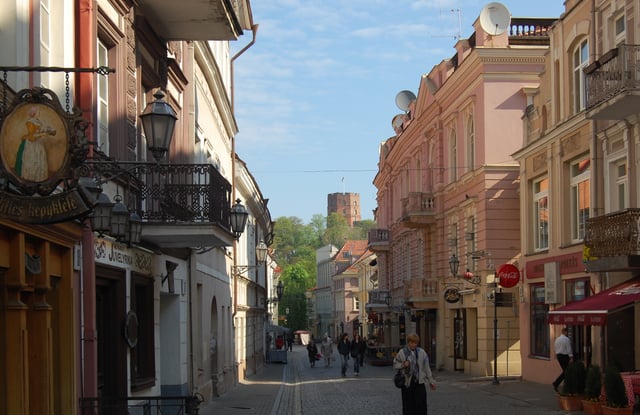
Vilnius Old Town apartments offers views to the most notable landmarks of the city and a medieval atmosphere
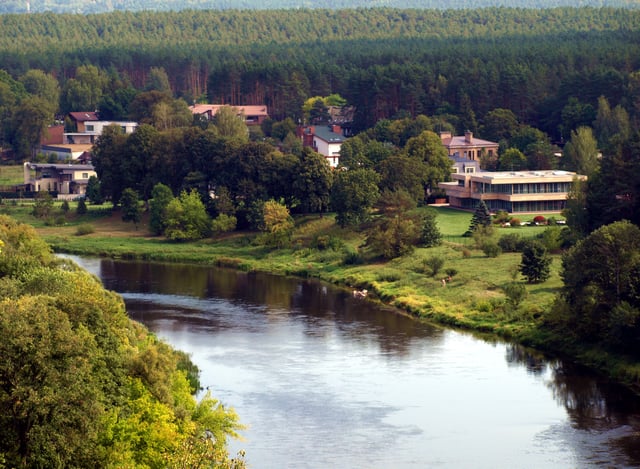
Part of Valakampiai neighborhood in Antakalnis eldership by the Neris River as seen from Verkiai Palace

Helios City complex in Naujamiestis with shopping mall and apartments
Vilnius Old Town (Lithuanian: Vilniaus senamiestis) with idyllic medieval stone paved streets and Užupis offers one of the most prestigious housing in Vilnius. Many old town apartment buildings there offers direct views to the iconic churches or the biggest landmarks of the city (e.g., especially desired Gediminas Tower), enclosed inner courtyards, high ceilings, attics, non-standard layouts and luxurious historic interiors.[143] Most expensive flats in these neighbourhoods may cost millions of euros and are accessible only to the wealthiest residents of the city.[144] However, such problems as traffic jams, expensive car parking spaces, air pollution, high costs of maintenance, limitations for reconstructions repels rich Vilnians from living in these neighbourhoods, who often buy or build private houses in more distant parts of Vilnius (Balsiai, Bajorai, Pavilnys, Kalnėnai, Pilaitė and others) or nearby areas of the Vilnius District Municipality.[143] About 21 000 residents live in the old town and 7 000 in Užupis.[145]
Valakampiai and Turniškės are the city's most prestigious places with private houses quarters as plots there are sufficiently large, surrounded with the greenery, pines forests and are easily accessible from the city centre. Generally, exceptionally wealthy residents and heads of the state (e.g., presidents) live there and most of the larger private houses costs millions of euros.[143][146] Part of the Žvėrynas neighbourhood also offers luxurious private houses with plots close to the Vingis Park, but it also has the Soviet-era apartment buildings, poor condition wooden houses, higher number of residents (~12 200[145]) and therefore is less prestigious among the wealthiest.[143]
Neighbourhoods around the old town (Antakalnis, Žirmūnai, Naujamiestis, Žvėrynas) offer a wide variety prices flats, decent amount of greenery suitable for walks, bicycle roads and therefore are the most popular among the middle class residents. Wealthier communities are living in a new construction apartments or renovated Soviet-era apartments.[143] Government of Lithuania strongly supports the renovation process and compensates 30% or more of the cost.[147] However, poorer inhabitants and low income pensioners are often stopping the process.[148]
More distant neighbourhoods (e.g., Lazdynai, Karoliniškės, Viršuliškės, Šeškinė, Justiniškės, Pašilaičiai, Fabijoniškės, Naujininkai) are offering significantly cheaper flats and are mostly inhabited by lower income or younger residents. Their biggest disadvantages together with a more difficult communication with the city centre are less greenery environment, mostly not renovated Soviet-era high-rise buildings, worn out surroundings, large traffic jams on the streets, connecting with the city centre during the rush hours and a constant lack of car parking spaces near older apartments.[143][149]
Šnipiškės eldership has received a significant amount of investment during the 2010s. The area was first mentioned in the Vilnius' historical documents in 1536 when the Grand Duke Sigismund I the Old ordered Ulrich Hosius to build a wooden bridge over the Neris river. Since then, this suburb of Vilnius was inhabited by more poor townspeople, who predominantly lived in wooden houses and engaged in gardening, making of bricks and pottery. However, in the 16th century magistrate of Vilnius built a palace dedicated to the Muscovites and Tatars messengers there, as during their visits, they acted noisily and the townspeople did not want them around, though the area still remained poor for centuries.[150] Everything has started to change rapidly in the early 2000s when the new Vilnius city municipality building was built there in 2004 and the area was named as the new city centre with skyscrapers and expensive commercial offices being built constantly in the area since then. Currently, it already has almost 0.5 million square meters of real estate.[151] A Japanese garden will be completed in the area till 2020.[152]
In 2019, average price for 1 m2 of flat was around 2000 euros and around 1200 euros for 1 m2 of a private house in Vilnius, while the rent prices were ~10 €/m2 (for flats) and ~8 €/m2 (for private houses) respectively.[153] According to the economists, number of transactions and housing affordability index has reached record highs in 2019 because of the significant rise in Vilnius residents incomes and slowing of the flats prices rising.[154] Despite that, according to a research one fourth of the 26–35 years old inhabitants are still living in their parents or relatives owned homes, which is the highest number in the Baltic states, however it is likely that large part of these young people are simply saving for their own homes or the initial contribution because statistics traditionally shows that Lithuanians purchases their homes with less borrowed funds than Latvians or Estonians.[155]
Demographics

More than 50 thousand inhabitants of Vilnius today live in the central part of the city (the Old town and the New Town) on the left bank of the Neris

The majority of Vilnius inhabitants nowadays live on the right bank of the Neris in neighborhoods, constructed during the last half of a century from the late 1960s and that are still being built in the 2010s.
1897: According to the first census in the Russian Empire, in 1897 population of Vilnius was 154,500. The largest linguistic groups at the time were those speaking Yiddish (61,847) and Polish (47,795). Other groups included Russian (30,967), Belarusian (6,514) and Ukrainian (517), Lithuanian (3,131), German (2,170), Tartar (722) and Latvian (184) speaking communities.[161]
According to the census, 52.4% of the inhabitants were local, while others settled in the city from other regions. Among the townsmen class, there were 36,576 newcomers (among whose, 17,465 were born in Vilna Governorate). Among the peasant newcomers, 16,312 came from other localities of Vilna Governorate and 16,054 from the other governorates. Among the nobility class in Vilnius during the census of 1897, there were 5,301 (46.3%) local nobles and 6,403 (54.7%) newcomers. 24.1% of these noble newcomers came from Vilna Governorate territories, while the rest newcomers nobles came to Vilnius from Grodno Governorate, Minsk Governorate, Vitebsk Governorate, Kovno Governorate, Vistula Land and other regions.[162] []
1916: According to the census of 14 December 1916 by the occupying German forces at the time, there were a total of 138,794 inhabitants in Vilnius. This number was made up of the following nationalities: Poles 53.67% (74,466 inhabitants), Jews 41.45% (57,516 inhabitants), Lithuanians 2.09% (2,909 inhabitants), Russians 1.59% (2,219 inhabitants), Germans 0.63% (880 inhabitants), Belarusians 0.44% (644 inhabitants) and others at 0.13% (193 inhabitants).
1923: 167,545 inhabitants, including 100,830 Poles and 55,437 Jews.[157]
1931: 196,345 inhabitants.[157] A census of 9 December 1931 reveals that Poles made up 65.9% of the total Vilnius population (128,600 inhabitants), Jews 28% (54,600 inhabitants), Russians 3.8% (7,400 inhabitants), Belarusians 0.9% (1,700 inhabitants), Lithuanians 0.8% (1,579 inhabitants), Germans 0.3% (600 inhabitants), Ukrainians 0.1% (200 inhabitants), others 0.2% (approx. 400 inhabitants). (The Wilno Voivodeship in the same year had 1,272,851 inhabitants, of which 511,741 used Polish as their language of communication; many Belarusians lived there.[157])
1959: According to the Soviet census, Vilnius had 236,100 inhabitants, of which 34% (79,400) identified themselves as Lithuanian, 29% (69,400) as Russian, 20% (47,200) as Polish, 7% (16,400) as Jewish and 6% (14,700) as Belarusian.[158]
1989: According to the Soviet census, Vilnius had 576,700 inhabitants, of which 50.5% (291,500) were Lithuanian, 20% Russian, 19% Polish and 5% Belarusian.[158]
2001: According to the 2001 census by the Vilnius Regional Statistical Office, there were 542,287 inhabitants in the Vilnius City Municipality, of which 57.8% were Lithuanians, 18.7% Poles, 14% Russians, 4.0% Belarusians, 1.3% Ukrainians and 0.5% Jews; the remainder indicated other nationalities or refused to answer.
2011: According to the 2011 census by Statistics Lithuania, Vilnius is inhabited by people of 128 different ethnicities which makes it the most ethnically diverse city in Lithuania, while the majority of Vilnius population is made up by Lithuanians (63.6%).[163] Poles, Russians, and Belarusians make up most of the remaining population.
Evolution
Demographic evolution of Vilnius between 1766 and 2017:
| Historical population | ||||||||||||||||||||||||||||||||||||||||||||||||||||||||||||||||||||||||||||||||||||||||||||||||||||||||||||||||||||||||||||||||||||||||||||||||||||||||||||||||||||
|---|---|---|---|---|---|---|---|---|---|---|---|---|---|---|---|---|---|---|---|---|---|---|---|---|---|---|---|---|---|---|---|---|---|---|---|---|---|---|---|---|---|---|---|---|---|---|---|---|---|---|---|---|---|---|---|---|---|---|---|---|---|---|---|---|---|---|---|---|---|---|---|---|---|---|---|---|---|---|---|---|---|---|---|---|---|---|---|---|---|---|---|---|---|---|---|---|---|---|---|---|---|---|---|---|---|---|---|---|---|---|---|---|---|---|---|---|---|---|---|---|---|---|---|---|---|---|---|---|---|---|---|---|---|---|---|---|---|---|---|---|---|---|---|---|---|---|---|---|---|---|---|---|---|---|---|---|---|---|---|---|---|---|---|---|
|
|
| ||||||||||||||||||||||||||||||||||||||||||||||||||||||||||||||||||||||||||||||||||||||||||||||||||||||||||||||||||||||||||||||||||||||||||||||||||||||||||||||||||
| Source: [162]:214, 303[164][165] ¹ Sharp decline after the Vilnius uprising (1794); ² Decline of population due to Napoleonic wars and the aftermath; ³ Sharp decline of population of Vilnius because of World War I and the aftermath during the clashes around Vilnius. These resulted in evacuation of Russian military, bureaucracy and the majority of its Russian inhabitants from Vilnius in 1915, as well as fleeing or evacuation of other Vilnius inhabitants of various communities (mostly Jewish and Lithuanian) to Russia and rural parts of Lithuania;[166][167] ⁴ Rise of population due to influx of Polish and Jewish war refugees[168] and migration of Lithuanian bureaucracy, students from temporary capital Kaunas and other localities in Lithuania; ⁵ Sharp decline of population after atrocities of World War II and The Holocaust | ||||||||||||||||||||||||||||||||||||||||||||||||||||||||||||||||||||||||||||||||||||||||||||||||||||||||||||||||||||||||||||||||||||||||||||||||||||||||||||||||||||
Economy

Vilnius modern skyline at dusk with the new city centre (Šnipiškės) in the middle

Europa Tower is the tallest building in the Baltic states and is one of the symbols of modern Vilnius and its economic growth

K29 business centre is the first and only office in the Baltic states with excellent BREEAM rating[173]
Vilnius is the major economic centre of Lithuania. GDP per capita (nominal) in Vilnius county was €21,300 (~$50,000, in Purchasing power)[169] in 2017, making it the wealthiest region in Lithuania and second wealthiest region in Baltic States.
Since 2010, employment and unemployment indicators have continuously been improving in Lithuania. Employment reached a record high of 77.5 % in the third quarter of 2018 while unemployment was 6.3 % in the fourth quarter, a rate last observed in 2008. Nevertheless, this has to be seen in the context of a shrinking working age population. The activity rate reached 82 % in 2017. Vilnius and Kaunas counties offer better labour market opportunities than other counties, and this drives the internal interregional migration. However, in other regions employment opportunities remain scarce. Unemployment rates remained persistently high in the least developed regions (14.9 % in Utena County as compared to 4.8 % in Vilnius County). Other key labour market indicators have improved, returning to pre-crisis levels. Long-term unemployment fell to 2.1 % in the third quarter of 2018 (EU average: 2.9 %). Youth unemployment (13.3 %) and the rate of young people not in employment, education or training (NEET, at 9.1 %) were below the EU average in 2017.[172]
Overall, the share of the population at risk of poverty or social exclusion (AROPE) has decreased since Lithuania joined the EU in 2004. However, it remains among the highest in the EU (29.6 % in 2017, compared to 22.4 % in the EU). The risk of poverty or social exclusion in rural areas is nearly double that of urban areas, which corresponds to the gap in the unemployment rate between cities and rural areas (4.5 % versus 11 % in 2017). In particular the metropolitan areas of Vilnius and Kaunas, where significant economic activity is centred, drive a significant gap between AROPE rates in urban and rural areas. In 2017, the AROPE rate in rural areas was 37.2 %, compared to 19.9 % in cities.[174]
Over the past 15 years, Lithuania has experienced the fastest convergence in the EU, but the benefits of economic growth are uneven across regions. Disparities among Lithuania's regions have steadily grown in this period. While GDP per capita reached nearly 110 % of the EU average in the capital region of Vilnius, it is only between 42 % and 77 % in other regions. The country’s rapid convergence is mainly fuelled by two regions — the capital region of Vilnius and Kaunas County — producing 42 % and 20 % of the national GDP, respectively. In 2014-2016 these regions grew on average by 4.6 % (Vilnius) and 3.3 % (Kaunas), while the other regions, which have a higher share of rural areas, stagnated or were in recession.[175]
The supply of new housing in Vilnius and its suburbs, the country’s biggest real estate market, has reached post-crisis highs and the stock of unsold apartments in the three largest cities has started to increase since the beginning of 2017. The demand for housing is still strong, fuelled by rapidly rising wages, benign financial conditions and positive expectations. In the first half of 2018, the number of monthly transactions was the highest since the 2007-2008 peak.[176] Most foreign direct investment and productive public investment in Lithuania is concentrated around the two main economic development poles of Vilnius and Kaunas.[177]
Vilnius Industrial Park is located 18.5 kilometres from the city and its land is intended for commercial, industrial use.[178]
Science and research
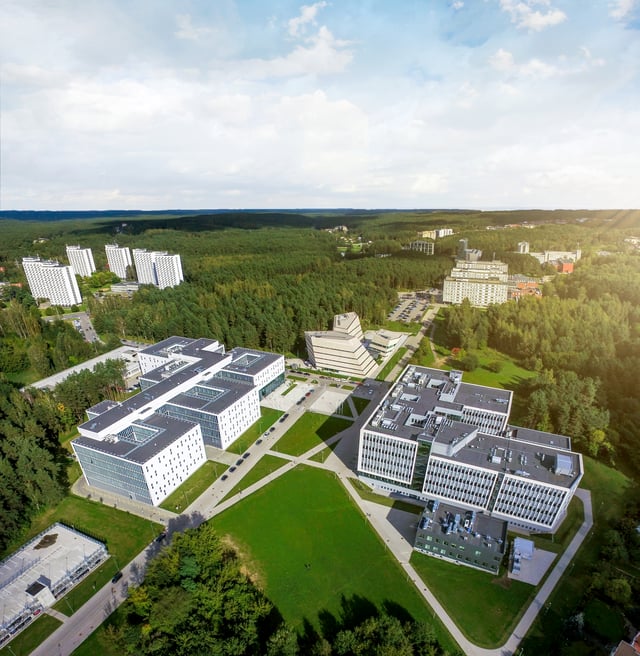
Scientific centres and universities faculties in the Sunrise Valley
Sunrise Valley Science and Technology Park (Lithuanian: Saulėtekio slėnio mokslo ir technologijų parkas) is a non-profit organization, founded in 2003. The park is the centre of entrepreneurship, promotion of business and science collaboration, provision of infrastructure and other innovation support. Over 20 000 students study in the Vilnius University and Vilnius Gediminas Technical University facilities in the Sunrise Valley and 5 000 scientists performs their research in the corresponding science centres there.[179]
Centre for Physical Sciences and Technology (Lithuanian: Fizinių ir technologijos mokslų centras) or FTMC is the largest scientific research institution in Lithuania, which specialises in laser technologies, optoelectronics, nuclear physics, organic chemistry, bio and nano technologies, electrochemical material science, electronics, and other scientific fields. The centre was created in 2010 by merging institutes of Chemistry, Physics, Semiconductor Physics in Vilnius and Textile institute in Kaunas.[180] Currently, the centre features 250 laboratories (24 open to the public) and can accommodate more than 700 researchers and students.[181] Furthermore, the centre also offers PhD Studies and annually helds FizTech conferences of PhD students and young researchers.[182] FTMC is the founder and sole shareholder of the Science and Technology Park of Institute of Physics in Savanorių Avenue, which provides assistance to companies operating in research and development field.[183]
Vilnius University Life Sciences Centre (Lithuanian: Vilniaus universiteto Gyvybės mokslų centras) is a scientific research centre, which consists of three institutes: Institute of Biochemistry, Institute of Biosciences and Institute of Biotechnology. The centre was opened in 2016 and currently has 900 students, ~120 PhD students and 250 scientific-pedagogical staff that are able to use open access scientific laboratories equipped with the most advanced equipment there.[184] Next to the main building there is a Technology Business Incubator for small and medium businesses in life sciences or related fields.[185]
Laser Research Centre of Vilnius University (Lithuanian: Vilniaus universiteto Lazerinių tyrimų centras) is an open access centre, mostly used by the Department of Quantum Electronics, which prepares highly qualified physicists, laser physicists and laser technology specialists. The department carries out world-class research in laser physics, nonlinear optics, optical component characterization, biophotonics and laser microtechnology.[186] Lithuania is one of the world's leaders in producing laser technologies and has over 50% of the world's market share in ultrashort pulses lasers, which are produced by the Vilnius-based companies.[187] In 2019, they developed one of the world's most powerful laser system in the world SYLOS for the Extreme Light Infrastructure laboratory in Szeged, which produces high-intensity ultra-short pulses with a peak power of up to a thousand times that of the most powerful nuclear power plant in the United States.[187]
Vilnius Gediminas Technical University has three research centres in the Sunrise Valley: Civil Engineering Research Centre, Technology Centre for Building Information and Digital Modelling, Competence Centre of Intermodal Transport and Logistics.[188]
Information technology
Lithuania and its capital Vilnius is an attractive place for foreign companies to open their offices. This is due to several main reasons – highly qualified employees and good infrastructure.[189] Several high schools are preparing skilled specialists in Vilnius, most notably the Vilnius University Faculty of Mathematics and Informatics and Vilnius Gediminas Technical University Faculty of Fundamental Sciences.[190][191] Sphere of the information technology is an attractive profession among the qualified professionals due to the high salaries in Vilnius (e.g., established in Vilnius Lithuanian branch of Google offers ~€17 800 monthly salary, which is one of the highest in Lithuania).[192] In 2018, the annual output of the information technology sector in Lithuania was €2.296 billion, of which large amount was created in Vilnius.[193]
National Cyber Security Centre of Lithuania was established in Vilnius due increasing internet attacks against the Lithuanian Government organizations.[198]
Bebras is an international informatics and information technology contest, which is held annually for pupils of 3-12 grades since 2004.[199] Since 2017, computer programming is taught in the primary schools.[200]
Finance and banking

The Bank of Lithuania headquarters in Gediminas Avenue
Being capital of Lithuania, Vilnius is the centre of country's finances. The Ministry of Finance is located in Vilnius and is responsible for the development and enforcement of an efficient public financial policy with a view to ensuring the macroeconomic stability of the state and its economic growth.[201] The Bank of Lithuania is also headquartered in Vilnius and fosters a reliable financial system and ensures sustainable economic growth.[202] Nasdaq Vilnius Stock Exchange, a leading stock exchange in Lithuania, is located in K29 business centre in Konstitucijos Avenue.[203]
The National Audit Office of Lithuania (Lithuanian: Lietuvos Respublikos valstybės kontrolė) is located in V. Kudirka Street and helps the state to manage public funds and property wisely.[204] While the State Tax Inspectorate (Lithuanian: Valstybinė mokesčių inspekcija) is headquartered in Vasario 16-osios Street and is responsible for collecting or refunding taxes in the country.[205]
At the time, 7 banks in Lithuania are holding a bank or a specialised bank licence, while 9 banks are carrying out their activities as foreign bank branches. The two largest banks registered in Lithuania (AB SEB bankas, Swedbank, AB,) are supervised directly by the European Central Bank jointly with Bank of Lithuania experts.[206]
The majority of the Lithuanian financial system consists of Nordic capital banks.[207]
Education

The Grand Courtyard of Vilnius University and Church of St. Johns
The city has 12 primary schools, 19 progymnasiums and 42 gymnasiums.[208]
The city has many universities. The largest and oldest is Vilnius University with 19,768 students.[209] Its main premises are in the Old Town. The university has been ranked among the top 500 universities in the world by QS World University Rankings.[210] The University is participating in projects with UNESCO and NATO, among others. It features Masters programs in English and Russian,[211] as well as programs delivered in cooperation with universities all over Europe. The university is currently divided into 14 faculties.[209]
Other major universities include Mykolas Romeris University (7,500 students[212]), Vilnius Gediminas Technical University (9,600 students[213]), and Lithuanian University of Educational Sciences (merged into Vytautas Magnus University in 2018[214]). Specialized higher schools with university status include General Jonas Žemaitis Military Academy of Lithuania, Lithuanian Academy of Music and Theatre and Vilnius Academy of Arts. The museum associated with the Vilnius Academy of Arts holds about 12,000 artworks.[215]
There are also a few private universities such as ISM University of Management and Economics, European Humanities University and Kazimieras Simonavičius University.
Several colleges are also in Vilnius including Vilnius College, Vilnius College of Technologies and Design, International School of Law and Business and others.
Libraries

One of the Central Vilnius University Library reading rooms, decorated in 1803 with the portraits of the 12 most prominent figures in antique art and science[216]
The Central Library of Vilnius City Municipality (Lithuanian: Vilniaus miesto savivaldybės centrinė biblioteka) operates public libraries in Vilnius.[217] It has 17 public libraries, located in different elderships of Vilnius, 2 of them (libraries Saulutė and Papartis) are dedicated to children's literature only.[218] Large part of these libraries organizes computer literacy courses that are free of charge.[219] Usage of public libraries requires a free LIBIS (integrated information system of Lithuanian libraries) card.[220]
Martynas Mažvydas National Library of Lithuania (Lithuanian: Lietuvos nacionalinė Martyno Mažvydo biblioteka), currently located in Gediminas Avenue and founded in 1919, is a national cultural institution which collects, organizes and preserves Lithuania's written cultural heritage content, develops the collection of Lithuanian and foreign documents relevant to research, educational and cultural needs of Lithuania, and provides library information services to the public.[221] As of 1 July, 2019 its electronic catalog has 1 140 708 bibliographic records.[222]
The Wroblewski Library of the Lithuanian Academy of Sciences (Lithuanian: Lietuvos mokslų akademijos Vrublevskių biblioteka) is a scientific library of state significance, a cultural, scientific and educational institution. Its founder is the Lithuanian Academy of Sciences. All citizens of Lithuania and foreign countries are entitled to use the services of the Library.[223] As of January 1, 2015, the stock of the Library counted 3 733 514 volumes. On January 1, 2015, the Wroblewski Library of the Lithuanian Academy of Sciences had 12.274 registered users.[223]
Every Lithuanian university and college has its own library, dedicated to their students, professors and alumnis. The most notable modern university library is the National Open Access Scientific Communication and Information Center of Vilnius University (Lithuanian: Vilniaus universiteto bibliotekos Mokslinės komunikacijos ir informacijos centras) in Saulėtekis Valley, which was opened in 2013 and offers over 800 workplaces in total area of 14043,61 m2.[224][225] Central Vilnius University Library,[226] Vilnius Gediminas Technical University Library,[227] Mykolas Romeris University Library,[228] ISM University of Management and Economics Library,[229] European Humanities University Library,[230] Kazimieras Simonavičius University Library[231] are located in these universities complexes in Vilnius.
Religion

Church of St. Casimir, the first and the oldest Baroque church in Vilnius

Orthodox Cathedral of the Theotokos, built in the 14th century
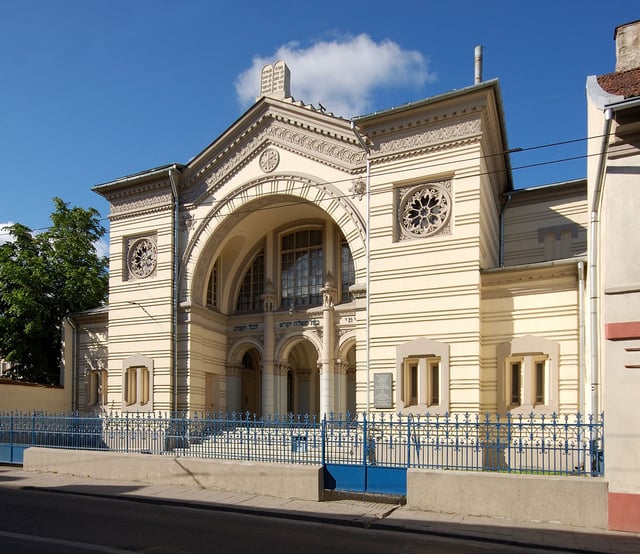
Choral Synagogue of Vilnius
Already in the 17th century Vilnius was known as a city of many religions. In 1600, Samuel Lewkenor's book describing cities with universities was published in London.[233] Lewkenor mentions that citizens of Vilnius included Catholics, Orthodox, followers of John Calvin and Martin Luther, Jews and Tartar Muslims.
Throughout the 17th century Vilnius had a reputation as a city which had no rivals in Europe in the number of churches of different confessions. At the end of the century, this reputation was confirmed by the highly regarded (and several times republished) work by Robert Morden, "Geography Rectified or a Description of the World", which said that no other city in the world could surpass Vilnius in the number of churches and temples of various faiths, except perhaps Amsterdam.[234][235]
Today Vilnius is the seat of the Roman Catholic Archdiocese of Vilnius, with the main church institutions and Archdiocesan Cathedral (Vilnius Cathedral) here. Numerous Christian Beatified persons, martyrs, Servants of God and Saints, are associated with Vilnius. These, among others, include Franciscan martyrs of Vilnius, Orthodox martyrs Anthony, John, and Eustathius, Saint Casimir, Josaphat Kuntsevych, Andrew Bobola, Raphael Kalinowski, Faustina Kowalska, Jurgis Matulaitis-Matulevičius.
There are a number of other active Roman Catholic churches in the city, along with small enclosed monasteries and religion schools. Church architecture includes Gothic, Renaissance, Baroque and Neoclassical styles, with important examples of each found in the Old Town. Additionally, Eastern Rite Catholicism has maintained a presence in Vilnius since the Union of Brest. The Baroque Basilian Gate is part of an Eastern Rite monastery.
Once widely known as Yerushalayim De Lita (the "Jerusalem of Lithuania"), Vilnius, since the 18th century, was a world centre for the study of the Torah, and had a large Jewish population. A major scholar of Judaism and Kabbalah centred in Vilnius was the famous Rabbi Eliyahu Kremer, also known as the Vilna Gaon. His writings have significant influence among Orthodox Jews to this day. Jewish life in Vilnius was destroyed during the Holocaust; there is a memorial stone dedicated to victims of Nazi genocide in the centre of the former Jewish Ghetto – now Mėsinių Street. The Vilna Gaon Jewish State Museum is dedicated to the history of Lithuanian Jewish life. The site of Vilnius's largest synagogue, built in the early 1630s and wrecked by Nazi Germany during its occupation of Lithuania, was found by ground-penetrating radar in June 2015, with excavations set to begin in 2016.[236][237]
The Karaites are a Jewish sect that migrated to Lithuania from the Crimea. Although their numbers are very small, the Karaites are becoming more prominent since Lithuanian independence, and have restored their kenesas (e.g., Vilnius Kenesa).[238]
Vilnius has been home to an Eastern Orthodox Christian presence since the 13th or even the 12th century. A famous Russian Orthodox Monastery of the Holy Spirit, is near the Gate of Dawn. St. Paraskeva's Orthodox Church in the Old Town is the site of the baptism of Hannibal, the great-grandfather of Pushkin, by Tsar Peter the Great in 1705. Many Old Believers, who split from the Russian Orthodox Church in 1667, settled in Lithuania. The Church of St. Michael and St. Constantine was built in 1913. Today a Supreme Council of the Old Believers is based in Vilnius.
Pilgrimage

The interior of the Chapel of the Gate of Dawn with the holy Our Lady of the Gate of Dawn painting

The first Divine Mercy painting by Eugeniusz Kazimirowski (1934) at the Divine Mercy Sanctuary, Vilnius
"It is safe to say that I have been in Vilnius all my life, at least since I became conscious. I was in Vilnius with thoughts and heart. One could say – the whole being. And so it stayed." — From the speech of Pope John Paul II at the Dominican Church of the Holy Spirit during his visit to Lithuania in 1993.[241]
Since the Christianization of Lithuania in 1387, Vilnius had become one of the main centres of Christianity in Lithuania and a Christian pilgrimage site. Vilnius Pilgrimage Center (Lithuanian: Vilniaus piligrimų centras) coordinates pilgrimages, assists in their proper preparation, and takes care of pilgrimage pastoral care.[242] Many places in Vilnius are associated with divine miracles or marks significant events to the Christians. Chapel of the Gate of Dawn is visited by thousands of Christian pilgrims annually. Initially, the gates were part of the defensive Wall of Vilnius, however in the 16th century they were given to the Carmelites, who installed a chapel in the gates with a prominent 17th century Catholic painting Our Lady of the Gate of Dawn. The painting was later decorated with gold-plated silver embellishments and is surrounded by a legend and divine miracles.[243]
Sanctuary of the Divine Mercy is another important pilgrimage site, which has the Divine Mercy image. Vilnius became the birthplace of the Divine Mercy Devotion when Saint Faustina began her mission under the guidance and discernment of her new spiritual director, blessed Michał Sopoćko. In 1934, the first Divine Mercy image was painted by Eugeniusz Kazimirowski under the supervision of Faustina Kowalska and it presently hangs in the Divine Mercy Sanctuary in Vilnius. A feast of the Adoration of the Blessed Sacrament is held in the shrine 24 hours per day.[243] The House of St. Faustina where she previously lived is located in V. Grybo St. in Antakalnis and is open to the pilgrims everyday.[244]
Church of St. Philip and St. Jacob near the Lukiškės Square has the painting of the Mother of God of Lukiškės, which is glorified by divine miracles.[243] The icon was painted in the 15th – 16th centuries and is one of the oldest monuments of easel painting in Lithuania.[245] It was brought by the Grand Duchy of Lithuania artillery general Motiejus Korvinas Gosievskis from the wars with Muscovites. From 1684 onwards miracles began to be experienced in the Vilnius Dominican Monastery, related to the image of Mother of God of Lukiškės, which in 1737 were published in a miracles book Mystical fountain (Lithuanian: Mistinis fontanas). The icon was restored and returned to the Dominicans in 2012.[246]
Three Crosses is a prominent monument in Vilnius. According to a debated legend of the Franciscan martyrs of Vilnius, presented in the Bychowiec Chronicle, fourteen Franciscan friars were invited to Vilnius from Podolia by Petras Goštautas.[247] The friars publicly preached the gospel and badmouthed Lithuanian gods. Angered city residents burned the monastery and killed all fourteen friars. Seven of them were beheaded on the Bleak Hill; the other seven were crucified and thrown into the Neris or Vilnia River.[247]
Vilnius is the only city in the Baltic states with an Apostolic Nunciature, in which Pope John Paul II and Pope Francis stayed during their visits to Lithuania, Latvia and Estonia.[249]
Parks, squares and cemeteries
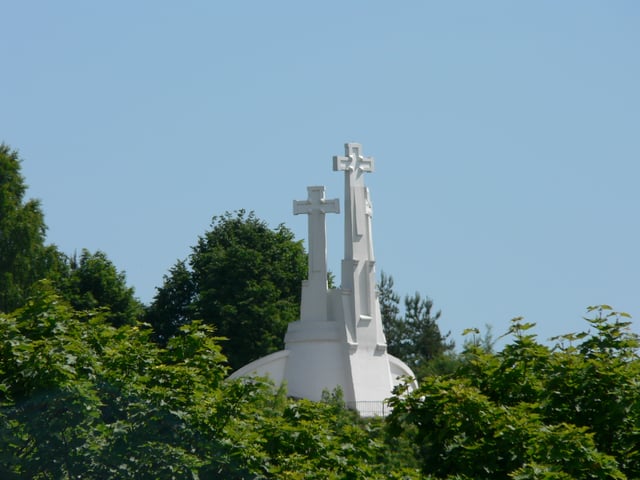
Three Crosses in Kalnai Park

Singing fountain in Bernardinai Garden
Almost half of Vilnius is covered by green areas, such as parks, public gardens, natural reserves. Additionally, Vilnius is host to numerous lakes, where residents and visitors swim and have barbecues in the summer. Thirty lakes and 16 rivers cover 2.1% of Vilnius' area, with some of them having sand beaches.
Vingis Park, the city's largest, hosted several major rallies during Lithuania's drive towards independence in the 1980s. Sections of the annual Vilnius Marathon pass along the public walkways on the banks of the Neris River. The green area next to the White Bridge is another popular area to enjoy good weather, and has become venue for several music and large screen events.
Cathedral Square in Old Town is surrounded by a number of the city's most historically significant sites. Lukiškės Square is the largest, bordered by several governmental buildings: the Lithuanian Ministry of Foreign Affairs, the Ministry of Finance, the Polish Embassy, and the Genocide Victims' Museum, where the KGB tortured and murdered numerous opposers of the communist regime. An oversized statue of Lenin in its centre was removed in 1991. Town Hall Square has long been a centre of trade fairs, celebrations, and events in Vilnius, including the Kaziukas Fair. The city Christmas tree is decorated there. State ceremonies are often held in Daukantas Square, facing the Presidential Palace.
On 20 October 2013, Bernardinai Garden, near Gediminas Tower, previously known as Sereikiškės Park, was opened after reconstruction. The authentic 19th-century Vladislovas Štrausas environment was restored.[250] It is a venue for concerts, festivals, and exhibitions.
Rasos Cemetery, consecrated in 1801, is the burial site of Jonas Basanavičius and other signatories of the 1918 Act of Independence, along with the heart of Polish leader Józef Piłsudski. Two of the three Jewish cemeteries in Vilnius were destroyed by communist authorities during the Soviet era; the remains of the Vilna Gaon were moved to the remaining one. A monument was erected at the place where Užupis Old Jewish Cemetery was.[251] About 18,000 burials have been made in the Bernardine Cemetery, established in 1810; it was closed during the 1970s and is now being restored. Antakalnis Cemetery, established in 1809, contains various memorials to Polish, Lithuanian, German and Russian soldiers, along with the graves of those who were killed during the January Events.
Tourism

Tourists in the Old Town of Vilnius
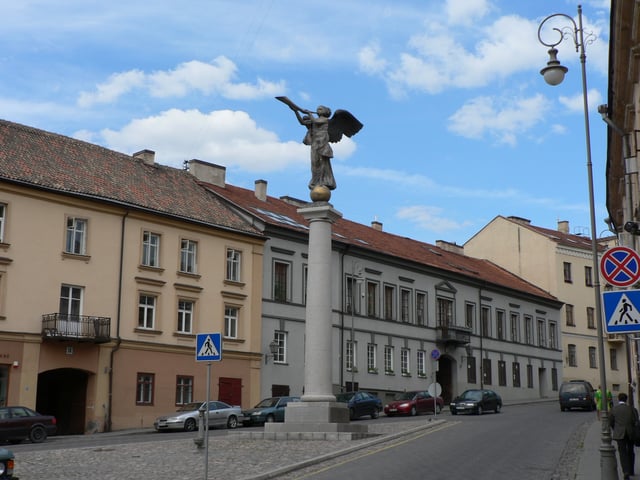
The Republic of Užupis
According to the data collected by the Lithuanian Department of Statistics, a total of 1 200 858 visitors had rented rooms in Vilnius accommodation venues where they spent a total of 2 212 109 nights in 2018. Compared to the 2017 statistics, the number of guests grew by 12,15% and 11,20% respectively.[252]
In 2018 80,82% of all the visitors who stayed in Vilnius were foreigners (970 577), which is 10,79% more than the previous year. Most foreign visitors came from Belarus (102 915), Germany (101 999), Poland (99 386), Russia (90 388) and Latvia (61 829). Guests from these countries accounted for 47,04% of all foreign guests, who rented rooms in Vilnius accommodation venues.[252] Entirely, 230 281 Lithuanians (19,18% of all guests) were in Vilnius accommodation venues during 2018 (which is 18,29% more than in 2017).[252]
According to a 2018 Vilnius Visitors Survey, 48,1% of tourists visited Vilnius for the first time, 85% of tourists planned the trip by themselves and only 15% travelled with travel agencies.[253] According to the same survey, 39,7% of tourists specified that they decided to visit Vilnius in order to learn about the history and heritage of the city, however 23,2% of tourists also planned trips to other areas of Lithuania (e.g., Trakai, Kaunas, Druskininkai, Šiauliai, etc.).[254] Many Belarusians (~200 000 granted travel visas annually) are arriving for shopping in the city's shopping malls and upon departing submits even half a meter long receipts to the customs.[255]
In 2018 Vilnius Tourist Information Centres were visited by a total of 119 136 visitors (95 932 foreigners and 23 204 Lithuanians), which is ~4,67 % more when compared with the 2017 statistics. In 2017 the centres were visited by 113 818 visitors (97 072 foreigners and 16 746 Lithuanians).[252]
The best-rated tourists services in Vilnius are restaurants (cafés) services quality, old town attractions, hotels (or other accommodation places) services, trips to Trakai, parks (green zones), connection with the Vilnius Airport, food in hotels, restaurants, cafés.[256]
Hotels

Grand Hotel Kempinski Vilnius
Lithuania is a member of the European Hotelstars Union, which is providing a harmonised hotel classification with common criteria and procedures in the participating countries.[257] Currently, Vilnius has six 5 stars hotels and they all are located in the Vilnius Old Town.[258] In addition to this, there are twenty-seven 4 stars hotels.[259] Grand Hotel Kempinski Vilnius with direct view to the Cathedral Square is considered as the most luxurious hotel in Vilnius and offers presidential rooms for around 3000 euros per night (more than three times of the average monthly net salary in Vilnius[170]) and is frequently chosen by the heads of state, movie stars, famous musicians and other celebrities during their visits to Lithuania.[260]
In 2018, Vilnius had 73 hotels, 6 motels and 49 other accommodation places with 6 145 rooms and 12 791 beds. Average room occupancy in Vilnius hotels reached 65,10% and bed occupancy was 48,40%. The highest hotels rooms’ occupancy was in August – rate accounted for 78 per cent.[252]
According to a 2018 Vilnius Visitors Survey, 43,8% of Vilnius visitors stayed in the middle class hotels (3-4 stars), 12,2% stayed in standard or economic class hotels (1-2 stars) and 11,2% stayed in luxurious 5 stars hotels.[261]
Sports
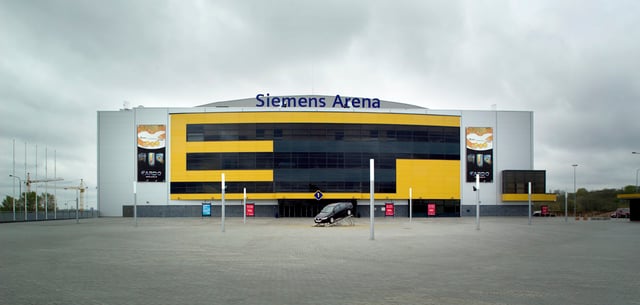
Siemens Arena
Several teams are based in the city. The largest is the basketball club BC Rytas, which participates in European competitions such as the Euroleague and Eurocup, the domestic Lithuanian Basketball League, winning the ULEB Cup (predecessor to the Eurocup) in 2005 and the Eurocup in 2009. Its home arena is the 2,500-seat Lietuvos Rytas Arena; all European matches and important domestic matches are played in the 11,000-seat Siemens Arena.
Vilnius also has several football teams. FK Žalgiris is the main football team. The club plays at LFF Stadium in Vilnius (capacity 5,067).[262]
Olympic champions in swimming Lina Kačiušytė and Robertas Žulpa are from Vilnius. There are several public swimming pools in Vilnius with Lazdynai Swimming Pool being the only Olympic-size swimming pool of the city.[263]
The city is home to the Lithuanian Bandy Association, Badminton Federation, Canoeing Sports Federation, Baseball Association, Biathlon Federation, Sailors Union, Football Federation, Fencing Federation, Cycling Sports Federation, Archery Federation, Athletics Federation, Ice Hockey Federation, Basketball Federation, Curling Federation, Rowing Federation, Wrestling Federation, Speed Skating Association, Gymnastics Federation, Equestrian Union, Modern Pentathlon Federation, Shooting Union, Triathlon Federation, Volleyball Federation, Tennis Union, Taekwondo Federation, Weightlifting Federation, Table Tennis Association, Skiing Association, Rugby Federation, Swimming Federation.[264]
Transport

Vilnius International Airport main entrance
Vilnius Airport serves most Lithuanian international flights to many major European destinations. Currently, the airport has about 50 destinations in about 25 different countries.[266] The airport is situated only 5 km (3.1 mi) away from the centre of the city, and has a direct rail link to Vilnius railway station.
The Vilnius railway station is an important hub serving direct passenger connections to Minsk, Kaliningrad, Moscow and Saint Petersburg as well as being a transit point of Pan-European Corridor IX.
Vilnius is the starting point of the A1 motorway that runs across Lithuania and connects the three major cities (Vilnius, Kaunas and Klaipėda) and is a part of European route E85. The A2 motorway, connecting Vilnius with Panevėžys, is a part of E272. Other highways starting in Vilnius include A3, A4, A14, A15, A16. Vilnius' Southern bypass is road A19.
Public transport

Solaris Urbino 18 bus and Škoda 26Tr Solaris trolleybuses in Vilnius

Orange bikes, available for renting
The bus network and the trolleybus network are run by Vilniaus viešasis transportas. There are over 60 bus, 18 trolleybus, 6 rapid bus and 6 night bus routes.[267] The trolleybus network is one of the most extensive in Europe. Over 250 buses and 260 trolleybuses transport about 500,000 passengers every workday.[268] The first regular bus routes were established in 1926, and the first trolleybuses were introduced in 1956.[269]
At the end of 2007, a new electronic monthly ticket system was introduced. It was possible to buy an electronic card in shops and newspaper stands and have it credited with an appropriate amount of money. The monthly e-ticket cards could be bought once and credited with an appropriate amount of money in various ways including the Internet. Previous paper monthly tickets were in use until August 2008.[270]
The ticket system changed again from 15 August 2012. E-Cards were replaced by Vilnius Citizen Cards ("Vilniečio Kortelė"). It is now possible to buy a card or change an old one in newspaper stands and have it credited with an appropriate amount of money or a particular type of ticket. Single trip tickets have been replaced by 30 and 60-minute tickets.
The public transportation system is dominated by the low-floor Volvo and Mercedes-Benz buses as well as Solaris trolleybuses. There are also plenty of the traditional Škoda vehicles, built in the Czech Republic, still in service, and many of these have been extensively refurbished internally. This is a result of major improvements that started in 2003 when the first brand-new Mercedes-Benz buses were bought. In 2004, a contract was signed with Volvo Buses to buy 90 brand-new 7700 buses over the following three years.[271]
In 2014 a mobile app was launched with public transport tickets on smartphones.[274]
In 2017, Vilnius started the historically largest upgrade of its buses by purchasing 250 new low-floor buses. The project will result in making 6 of 10 public buses being brand new by the middle of 2018 and will allow its passengers to use such modern technologies as free Wi-Fi and to charge their electronic devices while traveling.[275] On 5 September 2017, 50 new Isuzu buses were presented and articulated Scania buses were promised in the very near future.[276] Vilnius City Municipality also held a contest for 41 new trolleybuses and its winner Solaris committed to deliver all trolleybuses until the autumn of 2018, which will also have the free Wi-Fi and charging features.[277] On November 13, Vilnius City Municipality signed a contract with Solaris for the remaining 150 Solaris Urbino buses of the newest IV generation (100 standard and 50 articulated), also with the free Wi-Fi and USB charging.[278] On 20 September, 2019 five all-electric Karsan Jest Electric autobuses were presented, which will serve the 89 route in narrow streets.[279]
Since 2017 a 30 minute ticket costs 0.65 euro, a 60 minute ticket costs 0.90 euro and a single ticket bought on board costs 1.00 euro. There are other types of tickets, both short-term and long-term. Various discounts for pupils, students and elder people are available.[280]
Twin towns – sister cities
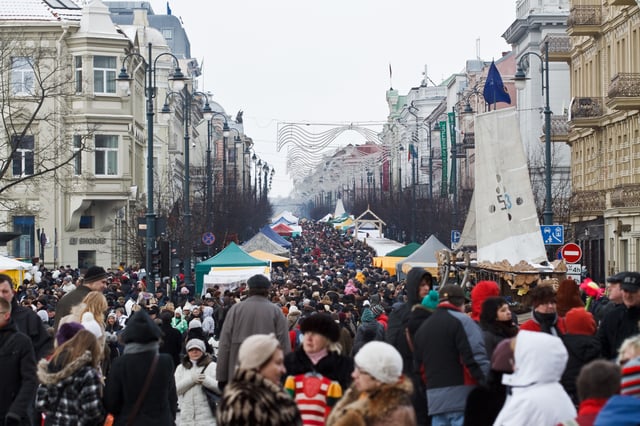
Traditional street fair Kaziuko mugė
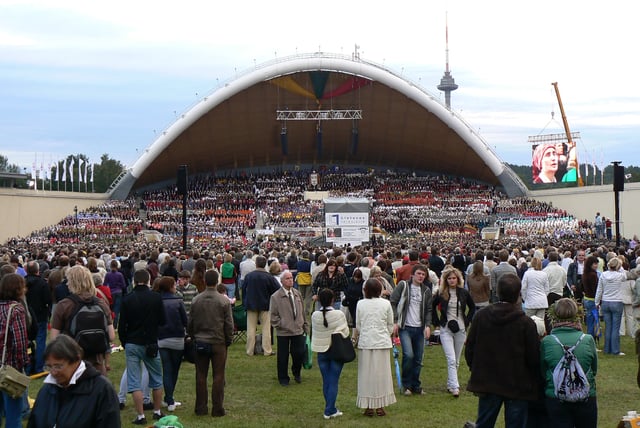
Lithuanian Song Festival

Daylight panorama of the city of Vilnius
[[INLINE_IMAGE|//upload.wikimedia.org/wikipedia/commons/thumb/9/9c/Flag_of_Denmark.svg/20px-Flag_of_Denmark.svg.png|//upload.wikimedia.org/wikipedia/commons/thumb/9/9c/Flag_of_Denmark.svg/31px-Flag_of_Denmark.svg.png 1.5x, //upload.wikimedia.org/wikipedia/commons/thumb/9/9c/Flag_of_Denmark.svg/40px-Flag_of_Denmark.svg.png 2x|Denmark|h15|w20|thumbborder flagicon-img flagicon-img]] Aalborg, Denmark
[[INLINE_IMAGE|//upload.wikimedia.org/wikipedia/commons/thumb/d/d3/Flag_of_Kazakhstan.svg/23px-Flag_of_Kazakhstan.svg.png|//upload.wikimedia.org/wikipedia/commons/thumb/d/d3/Flag_of_Kazakhstan.svg/35px-Flag_of_Kazakhstan.svg.png 1.5x, //upload.wikimedia.org/wikipedia/commons/thumb/d/d3/Flag_of_Kazakhstan.svg/46px-Flag_of_Kazakhstan.svg.png 2x|Kazakhstan|h12|w23|thumbborder flagicon-img flagicon-img]] Almaty, Kazakhstan
[[INLINE_IMAGE|//upload.wikimedia.org/wikipedia/commons/thumb/9/92/Flag_of_Belgium_%28civil%29.svg/23px-Flag_of_Belgium_%28civil%29.svg.png|//upload.wikimedia.org/wikipedia/commons/thumb/9/92/Flag_of_Belgium_%28civil%29.svg/35px-Flag_of_Belgium_%28civil%29.svg.png 1.5x, //upload.wikimedia.org/wikipedia/commons/thumb/9/92/Flag_of_Belgium_%28civil%29.svg/45px-Flag_of_Belgium_%28civil%29.svg.png 2x|Belgium|h15|w23|thumbborder flagicon-img flagicon-img]] Brussels, Belgium
[[INLINE_IMAGE|//upload.wikimedia.org/wikipedia/commons/thumb/c/c1/Flag_of_Hungary.svg/23px-Flag_of_Hungary.svg.png|//upload.wikimedia.org/wikipedia/commons/thumb/c/c1/Flag_of_Hungary.svg/35px-Flag_of_Hungary.svg.png 1.5x, //upload.wikimedia.org/wikipedia/commons/thumb/c/c1/Flag_of_Hungary.svg/46px-Flag_of_Hungary.svg.png 2x|Hungary|h12|w23|thumbborder flagicon-img flagicon-img]] Budapest, Hungary
[[INLINE_IMAGE|//upload.wikimedia.org/wikipedia/en/thumb/a/a4/Flag_of_the_United_States.svg/23px-Flag_of_the_United_States.svg.png|//upload.wikimedia.org/wikipedia/en/thumb/a/a4/Flag_of_the_United_States.svg/35px-Flag_of_the_United_States.svg.png 1.5x, //upload.wikimedia.org/wikipedia/en/thumb/a/a4/Flag_of_the_United_States.svg/46px-Flag_of_the_United_States.svg.png 2x|United States|h12|w23|thumbborder flagicon-img flagicon-img]] Chicago, United States
[[INLINE_IMAGE|//upload.wikimedia.org/wikipedia/commons/thumb/2/27/Flag_of_Moldova.svg/23px-Flag_of_Moldova.svg.png|//upload.wikimedia.org/wikipedia/commons/thumb/2/27/Flag_of_Moldova.svg/35px-Flag_of_Moldova.svg.png 1.5x, //upload.wikimedia.org/wikipedia/commons/thumb/2/27/Flag_of_Moldova.svg/46px-Flag_of_Moldova.svg.png 2x|Moldova|h12|w23|thumbborder flagicon-img flagicon-img]] Chișinău, Moldova
[[INLINE_IMAGE|//upload.wikimedia.org/wikipedia/commons/thumb/4/49/Flag_of_Ukraine.svg/23px-Flag_of_Ukraine.svg.png|//upload.wikimedia.org/wikipedia/commons/thumb/4/49/Flag_of_Ukraine.svg/35px-Flag_of_Ukraine.svg.png 1.5x, //upload.wikimedia.org/wikipedia/commons/thumb/4/49/Flag_of_Ukraine.svg/45px-Flag_of_Ukraine.svg.png 2x|Ukraine|h15|w23|thumbborder flagicon-img flagicon-img]] Dnipro, Ukraine
[[INLINE_IMAGE|//upload.wikimedia.org/wikipedia/commons/thumb/4/49/Flag_of_Ukraine.svg/23px-Flag_of_Ukraine.svg.png|//upload.wikimedia.org/wikipedia/commons/thumb/4/49/Flag_of_Ukraine.svg/35px-Flag_of_Ukraine.svg.png 1.5x, //upload.wikimedia.org/wikipedia/commons/thumb/4/49/Flag_of_Ukraine.svg/45px-Flag_of_Ukraine.svg.png 2x|Ukraine|h15|w23|thumbborder flagicon-img flagicon-img]] Donetsk, Ukraine
[[INLINE_IMAGE|//upload.wikimedia.org/wikipedia/en/thumb/b/ba/Flag_of_Germany.svg/23px-Flag_of_Germany.svg.png|//upload.wikimedia.org/wikipedia/en/thumb/b/ba/Flag_of_Germany.svg/35px-Flag_of_Germany.svg.png 1.5x, //upload.wikimedia.org/wikipedia/en/thumb/b/ba/Flag_of_Germany.svg/46px-Flag_of_Germany.svg.png 2x|Germany|h14|w23|thumbborder flagicon-img flagicon-img]] Duisburg, Germany
[[INLINE_IMAGE|//upload.wikimedia.org/wikipedia/commons/thumb/1/10/Flag_of_Scotland.svg/23px-Flag_of_Scotland.svg.png|//upload.wikimedia.org/wikipedia/commons/thumb/1/10/Flag_of_Scotland.svg/35px-Flag_of_Scotland.svg.png 1.5x, //upload.wikimedia.org/wikipedia/commons/thumb/1/10/Flag_of_Scotland.svg/46px-Flag_of_Scotland.svg.png 2x|Scotland|h14|w23|thumbborder flagicon-img flagicon-img]] Edinburgh, Scotland, United Kingdom
[[INLINE_IMAGE|//upload.wikimedia.org/wikipedia/en/thumb/b/ba/Flag_of_Germany.svg/23px-Flag_of_Germany.svg.png|//upload.wikimedia.org/wikipedia/en/thumb/b/ba/Flag_of_Germany.svg/35px-Flag_of_Germany.svg.png 1.5x, //upload.wikimedia.org/wikipedia/en/thumb/b/ba/Flag_of_Germany.svg/46px-Flag_of_Germany.svg.png 2x|Germany|h14|w23|thumbborder flagicon-img flagicon-img]] Erfurt, Germany
[[INLINE_IMAGE|//upload.wikimedia.org/wikipedia/en/thumb/1/12/Flag_of_Poland.svg/23px-Flag_of_Poland.svg.png|//upload.wikimedia.org/wikipedia/en/thumb/1/12/Flag_of_Poland.svg/35px-Flag_of_Poland.svg.png 1.5x, //upload.wikimedia.org/wikipedia/en/thumb/1/12/Flag_of_Poland.svg/46px-Flag_of_Poland.svg.png 2x|Poland|h14|w23|thumbborder flagicon-img flagicon-img]] Gdańsk, Poland
[[INLINE_IMAGE|//upload.wikimedia.org/wikipedia/commons/thumb/f/fa/Flag_of_the_People%27s_Republic_of_China.svg/23px-Flag_of_the_People%27s_Republic_of_China.svg.png|//upload.wikimedia.org/wikipedia/commons/thumb/f/fa/Flag_of_the_People%27s_Republic_of_China.svg/35px-Flag_of_the_People%27s_Republic_of_China.svg.png 1.5x, //upload.wikimedia.org/wikipedia/commons/thumb/f/fa/Flag_of_the_People%27s_Republic_of_China.svg/45px-Flag_of_the_People%27s_Republic_of_China.svg.png 2x|China|h15|w23|thumbborder flagicon-img flagicon-img]] Guangzhou, China
[[INLINE_IMAGE|//upload.wikimedia.org/wikipedia/commons/thumb/b/bc/Flag_of_Finland.svg/23px-Flag_of_Finland.svg.png|//upload.wikimedia.org/wikipedia/commons/thumb/b/bc/Flag_of_Finland.svg/35px-Flag_of_Finland.svg.png 1.5x, //upload.wikimedia.org/wikipedia/commons/thumb/b/bc/Flag_of_Finland.svg/46px-Flag_of_Finland.svg.png 2x|Finland|h14|w23|thumbborder flagicon-img flagicon-img]] Joensuu, Finland
[[INLINE_IMAGE|//upload.wikimedia.org/wikipedia/commons/thumb/4/49/Flag_of_Ukraine.svg/23px-Flag_of_Ukraine.svg.png|//upload.wikimedia.org/wikipedia/commons/thumb/4/49/Flag_of_Ukraine.svg/35px-Flag_of_Ukraine.svg.png 1.5x, //upload.wikimedia.org/wikipedia/commons/thumb/4/49/Flag_of_Ukraine.svg/45px-Flag_of_Ukraine.svg.png 2x|Ukraine|h15|w23|thumbborder flagicon-img flagicon-img]] Kiev, Ukraine
[[INLINE_IMAGE|//upload.wikimedia.org/wikipedia/en/thumb/1/12/Flag_of_Poland.svg/23px-Flag_of_Poland.svg.png|//upload.wikimedia.org/wikipedia/en/thumb/1/12/Flag_of_Poland.svg/35px-Flag_of_Poland.svg.png 1.5x, //upload.wikimedia.org/wikipedia/en/thumb/1/12/Flag_of_Poland.svg/46px-Flag_of_Poland.svg.png 2x|Poland|h14|w23|thumbborder flagicon-img flagicon-img]] Kraków, Poland
[[INLINE_IMAGE|//upload.wikimedia.org/wikipedia/en/thumb/1/12/Flag_of_Poland.svg/23px-Flag_of_Poland.svg.png|//upload.wikimedia.org/wikipedia/en/thumb/1/12/Flag_of_Poland.svg/35px-Flag_of_Poland.svg.png 1.5x, //upload.wikimedia.org/wikipedia/en/thumb/1/12/Flag_of_Poland.svg/46px-Flag_of_Poland.svg.png 2x|Poland|h14|w23|thumbborder flagicon-img flagicon-img]] Łódź, Poland
[[INLINE_IMAGE|//upload.wikimedia.org/wikipedia/en/thumb/a/a4/Flag_of_the_United_States.svg/23px-Flag_of_the_United_States.svg.png|//upload.wikimedia.org/wikipedia/en/thumb/a/a4/Flag_of_the_United_States.svg/35px-Flag_of_the_United_States.svg.png 1.5x, //upload.wikimedia.org/wikipedia/en/thumb/a/a4/Flag_of_the_United_States.svg/46px-Flag_of_the_United_States.svg.png 2x|United States|h12|w23|thumbborder flagicon-img flagicon-img]] Madison, United States
[[INLINE_IMAGE|//upload.wikimedia.org/wikipedia/commons/thumb/8/85/Flag_of_Belarus.svg/23px-Flag_of_Belarus.svg.png|//upload.wikimedia.org/wikipedia/commons/thumb/8/85/Flag_of_Belarus.svg/35px-Flag_of_Belarus.svg.png 1.5x, //upload.wikimedia.org/wikipedia/commons/thumb/8/85/Flag_of_Belarus.svg/46px-Flag_of_Belarus.svg.png 2x|Belarus|h12|w23|thumbborder flagicon-img flagicon-img]] Minsk, Belarus
[[INLINE_IMAGE|//upload.wikimedia.org/wikipedia/en/thumb/f/f3/Flag_of_Russia.svg/23px-Flag_of_Russia.svg.png|//upload.wikimedia.org/wikipedia/en/thumb/f/f3/Flag_of_Russia.svg/35px-Flag_of_Russia.svg.png 1.5x, //upload.wikimedia.org/wikipedia/en/thumb/f/f3/Flag_of_Russia.svg/45px-Flag_of_Russia.svg.png 2x|Russia|h15|w23|thumbborder flagicon-img flagicon-img]] Moscow, Russia
[[INLINE_IMAGE|//upload.wikimedia.org/wikipedia/commons/thumb/d/d3/Flag_of_Kazakhstan.svg/23px-Flag_of_Kazakhstan.svg.png|//upload.wikimedia.org/wikipedia/commons/thumb/d/d3/Flag_of_Kazakhstan.svg/35px-Flag_of_Kazakhstan.svg.png 1.5x, //upload.wikimedia.org/wikipedia/commons/thumb/d/d3/Flag_of_Kazakhstan.svg/46px-Flag_of_Kazakhstan.svg.png 2x|Kazakhstan|h12|w23|thumbborder flagicon-img flagicon-img]] Nur-Sultan, Kazakhstan
[[INLINE_IMAGE|//upload.wikimedia.org/wikipedia/commons/thumb/d/d9/Flag_of_Norway.svg/21px-Flag_of_Norway.svg.png|//upload.wikimedia.org/wikipedia/commons/thumb/d/d9/Flag_of_Norway.svg/32px-Flag_of_Norway.svg.png 1.5x, //upload.wikimedia.org/wikipedia/commons/thumb/d/d9/Flag_of_Norway.svg/41px-Flag_of_Norway.svg.png 2x|Norway|h15|w21|thumbborder flagicon-img flagicon-img]] Oslo, Norway
[[INLINE_IMAGE|//upload.wikimedia.org/wikipedia/en/thumb/0/03/Flag_of_Italy.svg/23px-Flag_of_Italy.svg.png|//upload.wikimedia.org/wikipedia/en/thumb/0/03/Flag_of_Italy.svg/35px-Flag_of_Italy.svg.png 1.5x, //upload.wikimedia.org/wikipedia/en/thumb/0/03/Flag_of_Italy.svg/45px-Flag_of_Italy.svg.png 2x|Italy|h15|w23|thumbborder flagicon-img flagicon-img]] Pavia, Italy
[[INLINE_IMAGE|//upload.wikimedia.org/wikipedia/commons/thumb/5/5c/Flag_of_Greece.svg/23px-Flag_of_Greece.svg.png|//upload.wikimedia.org/wikipedia/commons/thumb/5/5c/Flag_of_Greece.svg/35px-Flag_of_Greece.svg.png 1.5x, //upload.wikimedia.org/wikipedia/commons/thumb/5/5c/Flag_of_Greece.svg/45px-Flag_of_Greece.svg.png 2x|Greece|h15|w23|thumbborder flagicon-img flagicon-img]] Piraeus, Greece
[[INLINE_IMAGE|//upload.wikimedia.org/wikipedia/commons/thumb/c/ce/Flag_of_Iceland.svg/21px-Flag_of_Iceland.svg.png|//upload.wikimedia.org/wikipedia/commons/thumb/c/ce/Flag_of_Iceland.svg/32px-Flag_of_Iceland.svg.png 1.5x, //upload.wikimedia.org/wikipedia/commons/thumb/c/ce/Flag_of_Iceland.svg/42px-Flag_of_Iceland.svg.png 2x|Iceland|h15|w21|thumbborder flagicon-img flagicon-img]] Reykjavík, Iceland
[[INLINE_IMAGE|//upload.wikimedia.org/wikipedia/commons/thumb/8/84/Flag_of_Latvia.svg/23px-Flag_of_Latvia.svg.png|//upload.wikimedia.org/wikipedia/commons/thumb/8/84/Flag_of_Latvia.svg/35px-Flag_of_Latvia.svg.png 1.5x, //upload.wikimedia.org/wikipedia/commons/thumb/8/84/Flag_of_Latvia.svg/46px-Flag_of_Latvia.svg.png 2x|Latvia|h12|w23|thumbborder flagicon-img flagicon-img]] Riga, Latvia
[[INLINE_IMAGE|//upload.wikimedia.org/wikipedia/en/thumb/f/f3/Flag_of_Russia.svg/23px-Flag_of_Russia.svg.png|//upload.wikimedia.org/wikipedia/en/thumb/f/f3/Flag_of_Russia.svg/35px-Flag_of_Russia.svg.png 1.5x, //upload.wikimedia.org/wikipedia/en/thumb/f/f3/Flag_of_Russia.svg/45px-Flag_of_Russia.svg.png 2x|Russia|h15|w23|thumbborder flagicon-img flagicon-img]] Saint Petersburg, Russia
[[INLINE_IMAGE|//upload.wikimedia.org/wikipedia/commons/thumb/4/41/Flag_of_Austria.svg/23px-Flag_of_Austria.svg.png|//upload.wikimedia.org/wikipedia/commons/thumb/4/41/Flag_of_Austria.svg/35px-Flag_of_Austria.svg.png 1.5x, //upload.wikimedia.org/wikipedia/commons/thumb/4/41/Flag_of_Austria.svg/45px-Flag_of_Austria.svg.png 2x|Austria|h15|w23|thumbborder flagicon-img flagicon-img]] Salzburg, Austria
[[INLINE_IMAGE|//upload.wikimedia.org/wikipedia/en/thumb/4/4c/Flag_of_Sweden.svg/23px-Flag_of_Sweden.svg.png|//upload.wikimedia.org/wikipedia/en/thumb/4/4c/Flag_of_Sweden.svg/35px-Flag_of_Sweden.svg.png 1.5x, //upload.wikimedia.org/wikipedia/en/thumb/4/4c/Flag_of_Sweden.svg/46px-Flag_of_Sweden.svg.png 2x|Sweden|h14|w23|thumbborder flagicon-img flagicon-img]] Stockholm, Sweden
[[INLINE_IMAGE|//upload.wikimedia.org/wikipedia/en/thumb/c/c3/Flag_of_France.svg/23px-Flag_of_France.svg.png|//upload.wikimedia.org/wikipedia/en/thumb/c/c3/Flag_of_France.svg/35px-Flag_of_France.svg.png 1.5x, //upload.wikimedia.org/wikipedia/en/thumb/c/c3/Flag_of_France.svg/45px-Flag_of_France.svg.png 2x|France|h15|w23|thumbborder flagicon-img flagicon-img]] Strasbourg, France
[[INLINE_IMAGE|//upload.wikimedia.org/wikipedia/commons/thumb/7/72/Flag_of_the_Republic_of_China.svg/23px-Flag_of_the_Republic_of_China.svg.png|//upload.wikimedia.org/wikipedia/commons/thumb/7/72/Flag_of_the_Republic_of_China.svg/35px-Flag_of_the_Republic_of_China.svg.png 1.5x, //upload.wikimedia.org/wikipedia/commons/thumb/7/72/Flag_of_the_Republic_of_China.svg/45px-Flag_of_the_Republic_of_China.svg.png 2x|Taiwan|h15|w23|thumbborder flagicon-img flagicon-img]] Taipei, Taiwan
[[INLINE_IMAGE|//upload.wikimedia.org/wikipedia/commons/thumb/8/8f/Flag_of_Estonia.svg/23px-Flag_of_Estonia.svg.png|//upload.wikimedia.org/wikipedia/commons/thumb/8/8f/Flag_of_Estonia.svg/35px-Flag_of_Estonia.svg.png 1.5x, //upload.wikimedia.org/wikipedia/commons/thumb/8/8f/Flag_of_Estonia.svg/46px-Flag_of_Estonia.svg.png 2x|Estonia|h15|w23|thumbborder flagicon-img flagicon-img]] Tallinn, Estonia
[[INLINE_IMAGE|//upload.wikimedia.org/wikipedia/commons/thumb/0/0f/Flag_of_Georgia.svg/23px-Flag_of_Georgia.svg.png|//upload.wikimedia.org/wikipedia/commons/thumb/0/0f/Flag_of_Georgia.svg/35px-Flag_of_Georgia.svg.png 1.5x, //upload.wikimedia.org/wikipedia/commons/thumb/0/0f/Flag_of_Georgia.svg/45px-Flag_of_Georgia.svg.png 2x|Georgia (country)|h15|w23|thumbborder flagicon-img flagicon-img]] Tbilisi, Georgia
[[INLINE_IMAGE|//upload.wikimedia.org/wikipedia/en/thumb/1/12/Flag_of_Poland.svg/23px-Flag_of_Poland.svg.png|//upload.wikimedia.org/wikipedia/en/thumb/1/12/Flag_of_Poland.svg/35px-Flag_of_Poland.svg.png 1.5x, //upload.wikimedia.org/wikipedia/en/thumb/1/12/Flag_of_Poland.svg/46px-Flag_of_Poland.svg.png 2x|Poland|h14|w23|thumbborder flagicon-img flagicon-img]] Warsaw, Poland
Significant depictions in popular culture
Vilnius is mentioned in the movie The Hunt for Red October (1990) as being the boyhood home of the sub commander Marko Ramius, and as being where his grandfather taught him to fish; he is also referenced once in the movie as "The Vilnius Schoolmaster". Ramius is played by Sean Connery.
Author Thomas Harris' character Hannibal Lecter is revealed to be from Vilnius and its aristocracy in the movie Hannibal Rising. Lecter is portrayed more popularly and often by Sir Anthony Hopkins, although Brian Cox played Lecter in the movie Manhunter.
The memoir A Partisan from Vilna (2010)[282] details the life and struggles of Rachel Margolis. Her family's sole survivor, she escaped from the Vilna Ghetto with other members of the resistance movement, the FPO (United Partisan Organization), and joined the Soviet partisans in the Lithuanian forests to sabotage the Nazis.
Vilnius is classified as a city-state in the turn-based strategy games Civilization V and "Civilization VI".
A well rated five-part historical drama television miniseries about Chernobyl nuclear disaster was mostly filmed in two Soviet-era elderships of Vilnius: Justiniškės and Fabijoniškės.[283][284]
Notable people
See also
Coat of arms of Vilnius
List of monuments in Vilnius
List of Vilnius Elderships in other languages
Neighborhoods of Vilnius
